Japandi bathroom design merges Japanese minimalism with Scandinavian warmth to create serene, functional spaces that promote relaxation and wellbeing. This design philosophy emphasizes natural materials, neutral color palettes, and clean lines while maintaining a connection to nature. The style celebrates simplicity without sacrificing comfort, incorporating elements like freestanding soaking tubs, warm wood accents, stone textures, and soft lighting. Japandi bathrooms serve as peaceful retreats from daily stress, featuring clutter-free layouts and thoughtful storage solutions. These spaces embrace the Japanese concept of wabi-sabi, finding beauty in imperfection, alongside Scandinavian hygge principles of coziness and comfort for truly harmonious bathroom environments.

1. Minimalist Wooden Soaking Tub Sanctuary
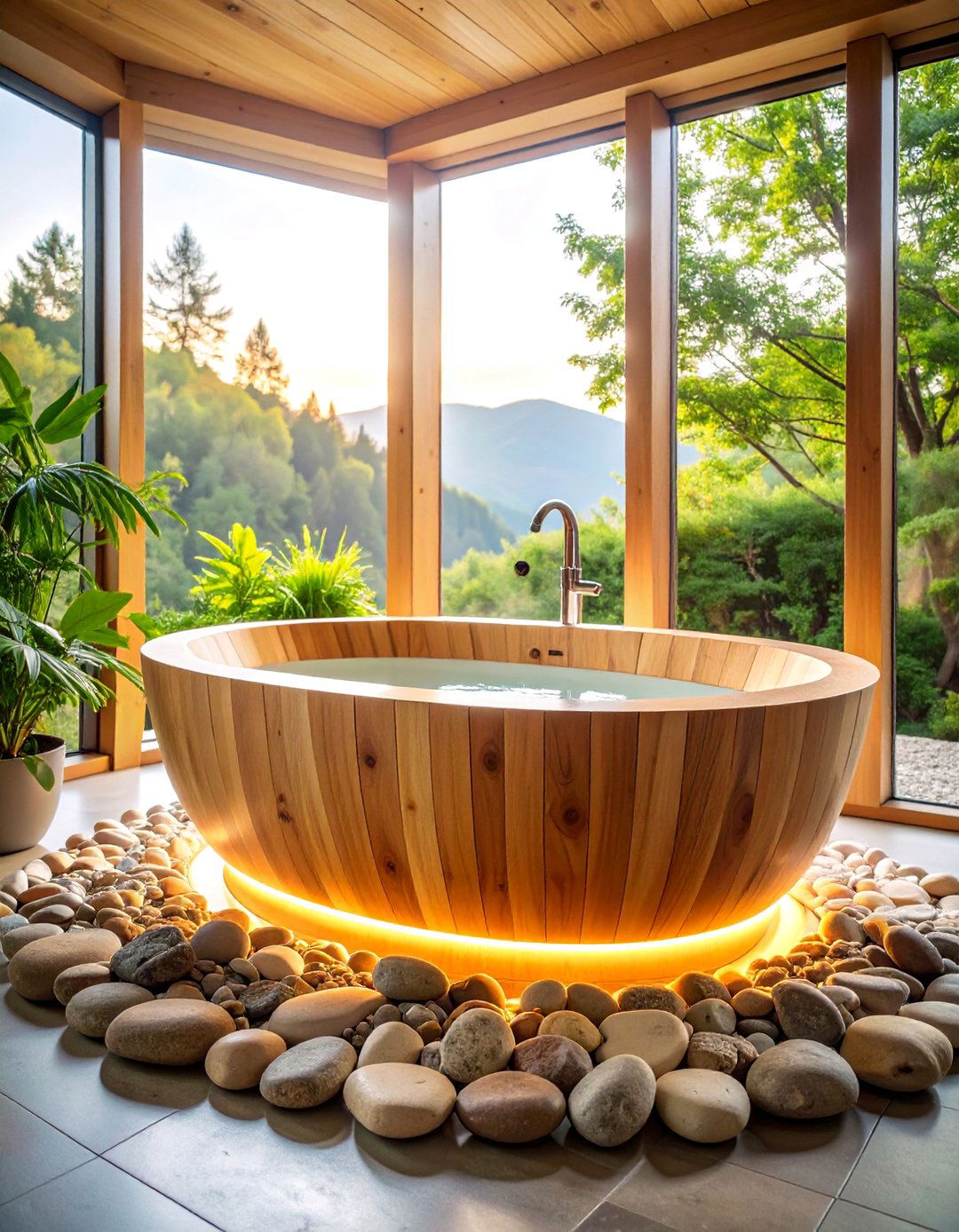
Transform your bathroom into a zen retreat with a deep wooden soaking tub as the centerpiece. Choose rich teak or cedar construction that showcases natural grain patterns while providing excellent water resistance. Position the tub near a large window to maximize natural light and create connection with outdoor greenery. Surround the area with smooth river stones or pebble tiles for authentic Japanese spa aesthetics. Install warm LED strip lighting beneath the tub platform to create gentle ambient illumination during evening baths. Add a simple wooden bath caddy to hold essential oils and natural sponges. Complete the space with bamboo privacy screens and minimal storage solutions that maintain the clean, uncluttered appearance essential to Japandi design principles.
2. Floating Vanity with Natural Stone Accents
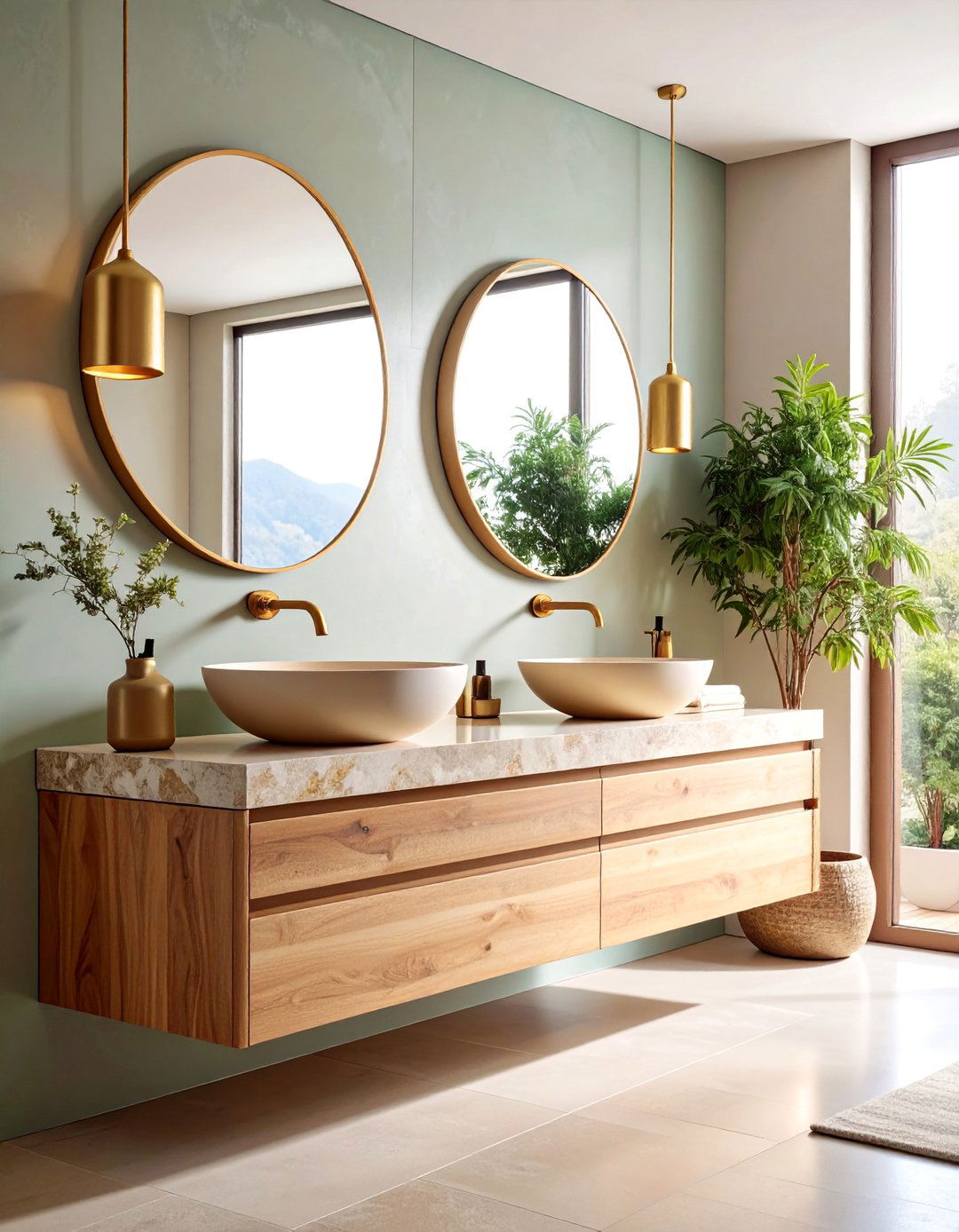
Create visual lightness with a wall-mounted wooden vanity featuring clean horizontal lines and integrated storage compartments. Select light oak or ash wood with natural finish to emphasize Scandinavian influences while maintaining Japanese simplicity. Top the vanity with honed marble or travertine countertops that provide subtle texture and organic variation. Install vessel sinks in natural stone or ceramic with organic curved shapes. Add brass or matte black fixtures for sophisticated contrast against neutral backgrounds. Incorporate recessed lighting above the mirror and underneath the vanity to enhance the floating effect. Include hidden storage drawers with soft-close mechanisms to maintain clutter-free surfaces. Complete with a large frameless mirror that reflects natural light throughout the space while supporting the minimalist aesthetic.
3. Pebble Floor Wet Room Design
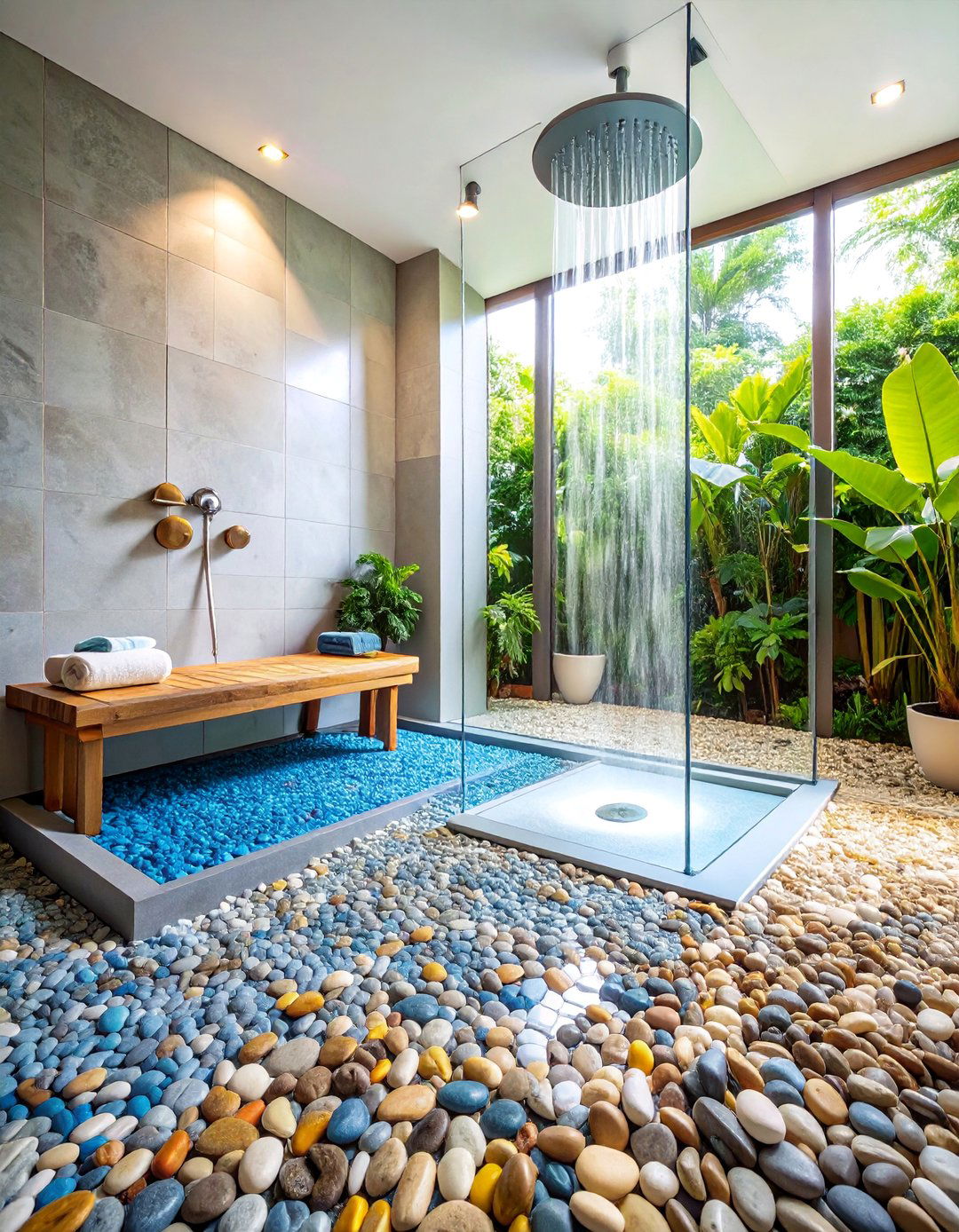
Design an open wet room concept featuring smooth pebble mosaic flooring that provides natural texture and excellent drainage. Choose neutral gray and beige river stones arranged in flowing patterns that guide water toward discrete floor drains. Install a rainfall showerhead with brass or matte black finish mounted from the ceiling for spa-like experience. Create separation between wet and dry areas using glass panels or natural stone half-walls topped with living plants. Add teak shower benches with slatted construction for both seating and storage of bath essentials. Include wall-mounted dispensers in natural materials to eliminate plastic bottles. Enhance the space with soft indirect lighting and small windows or skylights that bring natural illumination while maintaining privacy and connection to nature.
4. Bamboo Feature Wall Bathroom
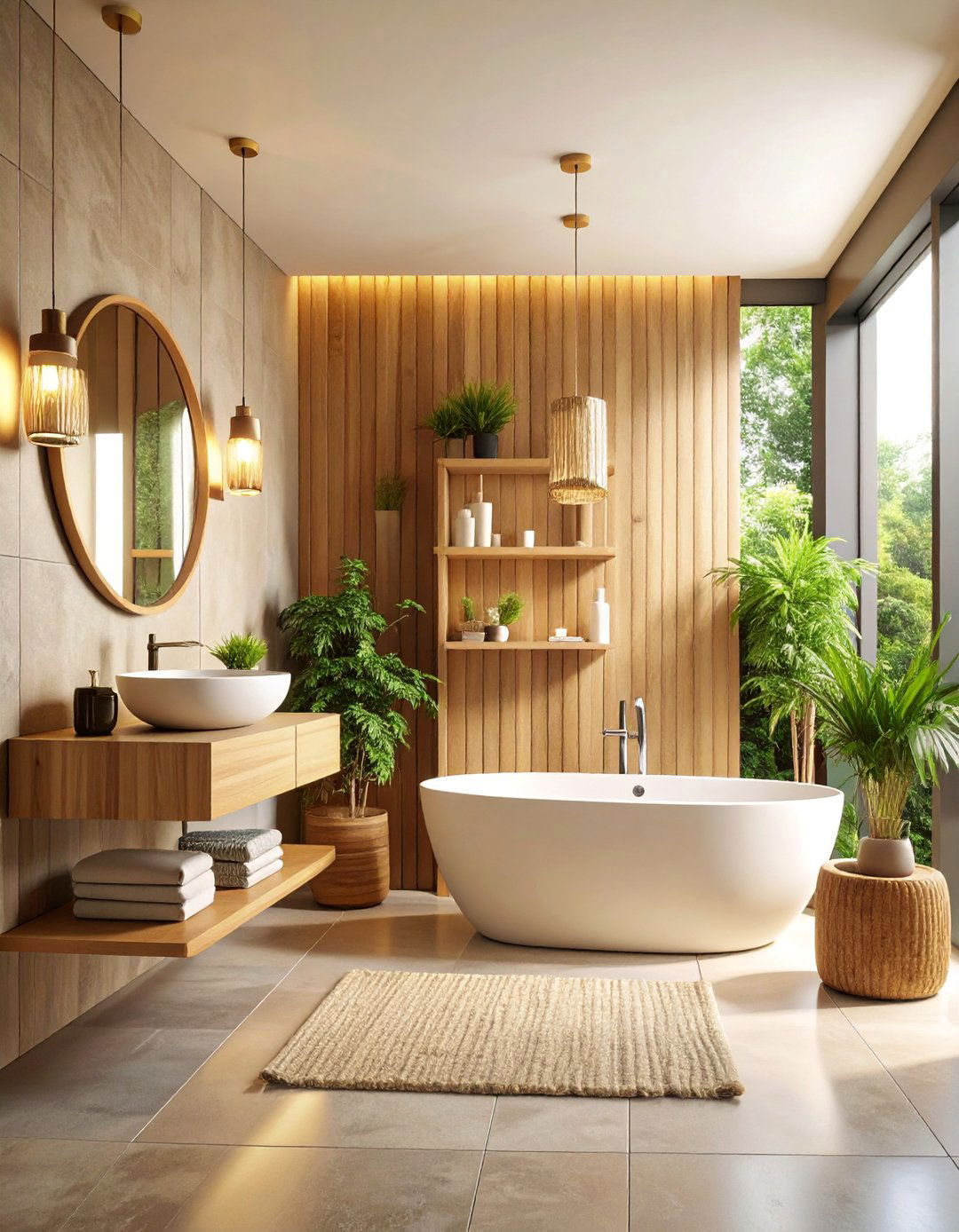
Incorporate vertical bamboo slats as a striking feature wall behind the vanity or bathtub area. Select sustainably sourced bamboo with natural golden tones that add warmth and texture to neutral color schemes. Install slats with subtle spacing to create interesting shadow patterns when illuminated by natural or artificial light sources. Combine bamboo with smooth concrete or stone surfaces for material contrast that exemplifies Japandi balance. Add floating shelves in matching bamboo for storing towels and decorative objects in organic ceramic vessels. Include pendant lighting with bamboo or rattan shades that complement the wall treatment. Paint remaining walls in soft white or warm beige to allow the bamboo feature to serve as the focal point while maintaining overall serenity and visual harmony.
5. Neutral Monochrome Spa Retreat
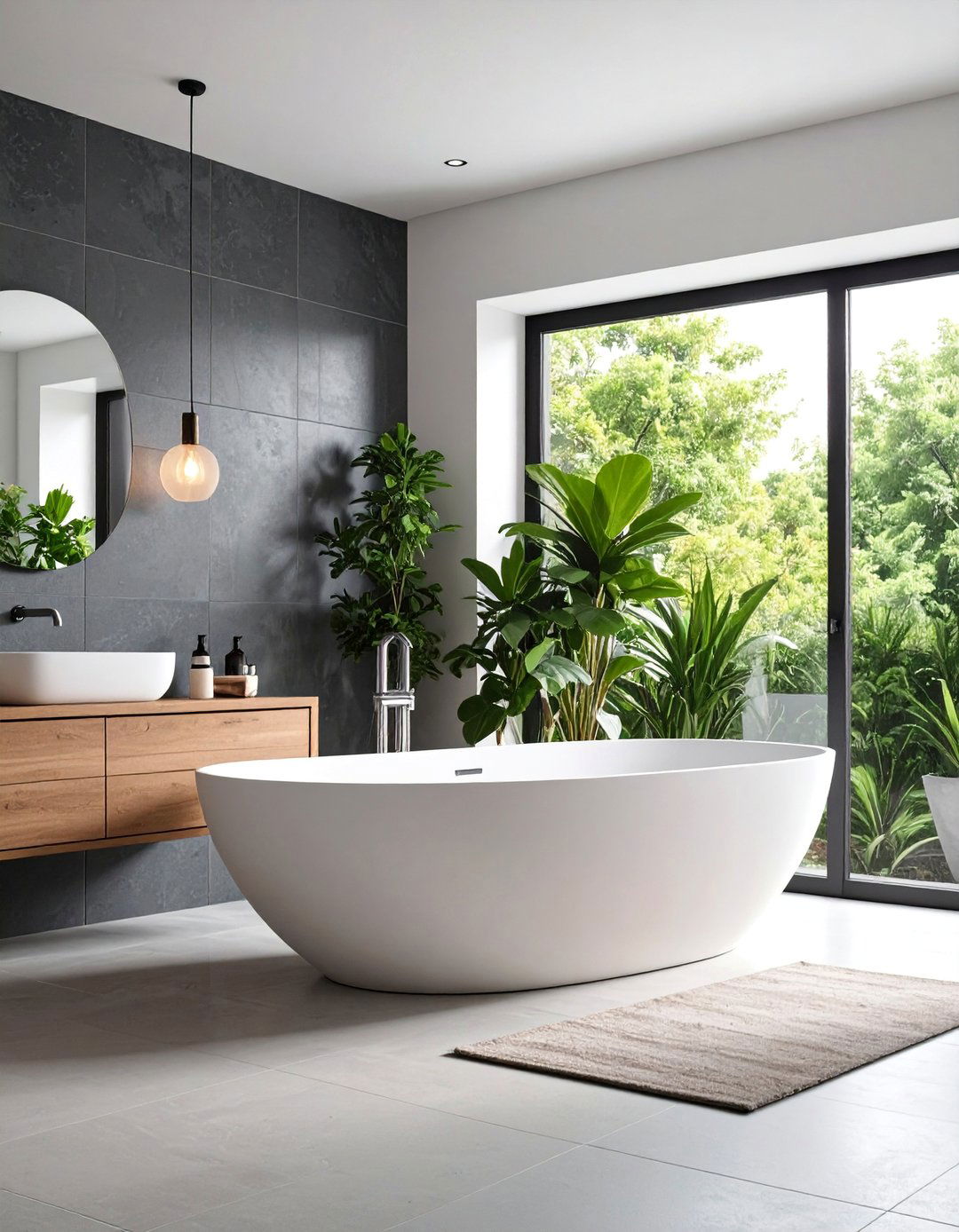
Create sophisticated tranquility using various shades of gray, white, and beige throughout the entire bathroom space. Layer different textures in similar tones through matte ceramic tiles, smooth stone countertops, and natural linen textiles. Install a freestanding white bathtub with simple geometric form as the room's centerpiece. Add charcoal or slate gray accent tiles in the shower area for subtle depth and visual interest. Choose fixtures in brushed nickel or matte black to provide refined contrast without disrupting the monochromatic harmony. Include soft textiles like organic cotton towels and bamboo bath mats in coordinating neutral shades. Enhance the space with carefully placed green plants that provide natural color accents while maintaining the overall calm and sophisticated atmosphere essential to Japandi aesthetics.
6. Japanese Soaking Tub with Garden Views
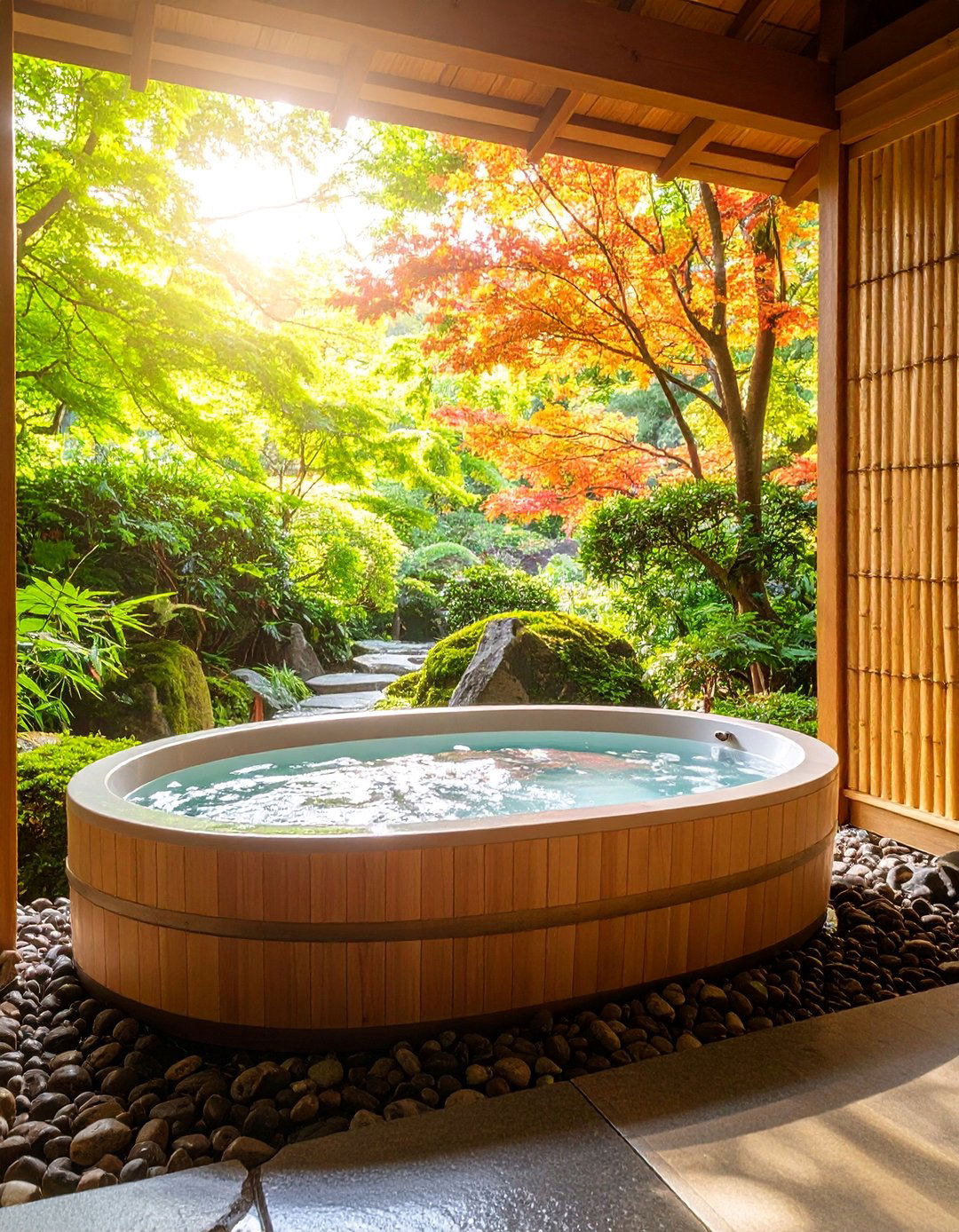
Install a traditional ofuro-style soaking tub positioned to maximize views of outdoor gardens or natural landscapes. Choose a deep, compact design that encourages mindful bathing rituals and relaxation. Surround the tub with natural stone or wooden decking that creates seamless transition between indoor and outdoor spaces. Install large windows or sliding glass doors that can be opened to enhance connection with nature. Add privacy screens made from bamboo or frosted glass that maintain seclusion while allowing natural light penetration. Include a small wooden stool and natural fiber towels for authentic Japanese bathing experience. Enhance the area with potted plants like bamboo or ferns that thrive in humid bathroom conditions while reinforcing the nature-inspired design philosophy central to Japandi style.
7. Concrete and Wood Modern Minimalism
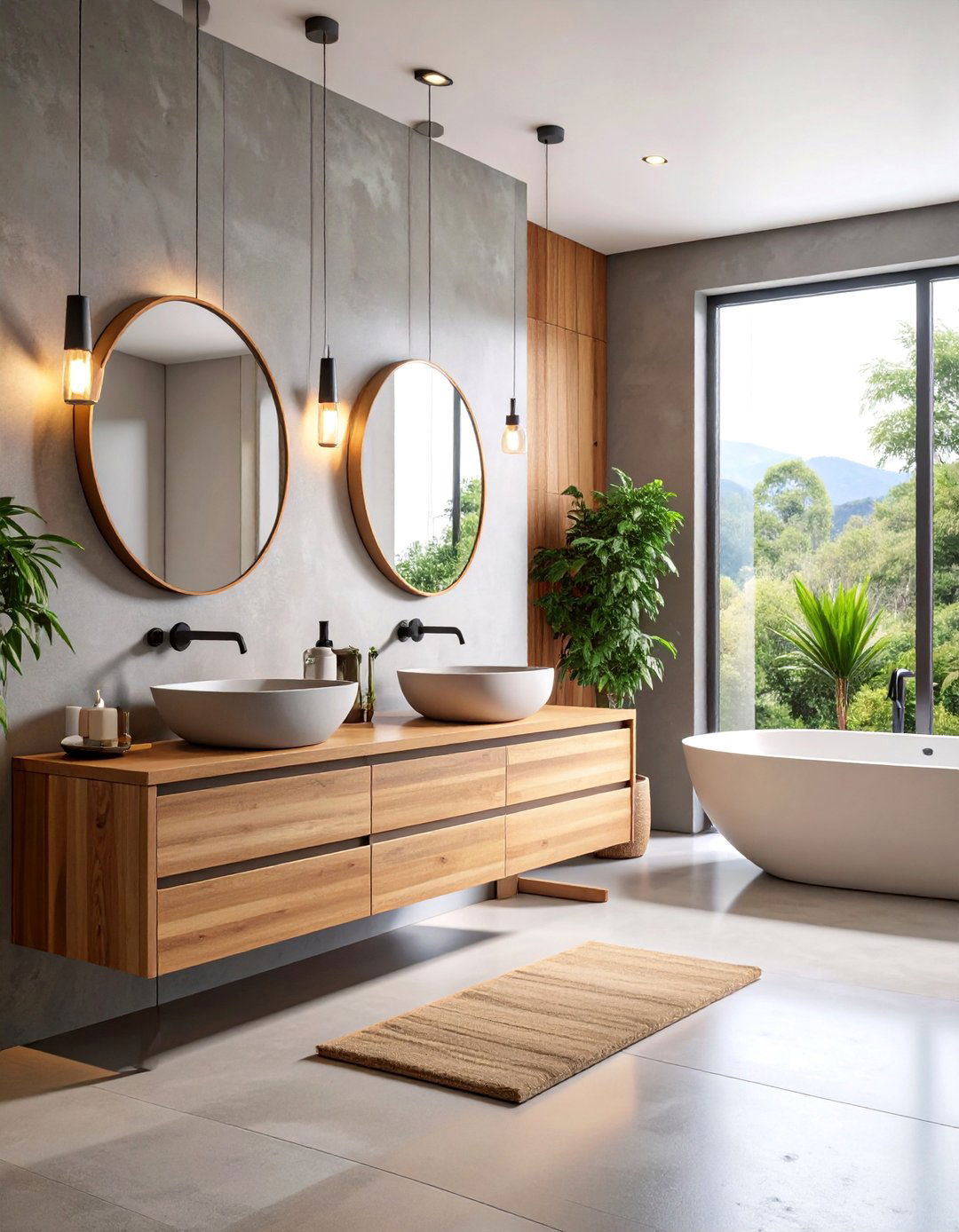
Combine raw concrete surfaces with warm wood accents to create contemporary Japandi sophistication. Use polished concrete for flooring and accent walls, providing durable surfaces with subtle industrial character. Balance hard concrete textures with warm wooden vanity cabinetry in light oak or birch finishes. Install geometric concrete sinks or basins that showcase clean modern lines. Add wooden floating shelves and accessories to introduce warmth and natural elements. Choose minimalist fixtures in matte black or brushed steel that complement both materials. Include hidden lighting systems that highlight the texture contrast between smooth concrete and natural wood grain. Complete with simple geometric mirrors and carefully selected plants that soften the hard surfaces while maintaining the clean, uncluttered aesthetic that defines Japandi interior design principles.
8. Terrazzo Stone Accent Bathroom
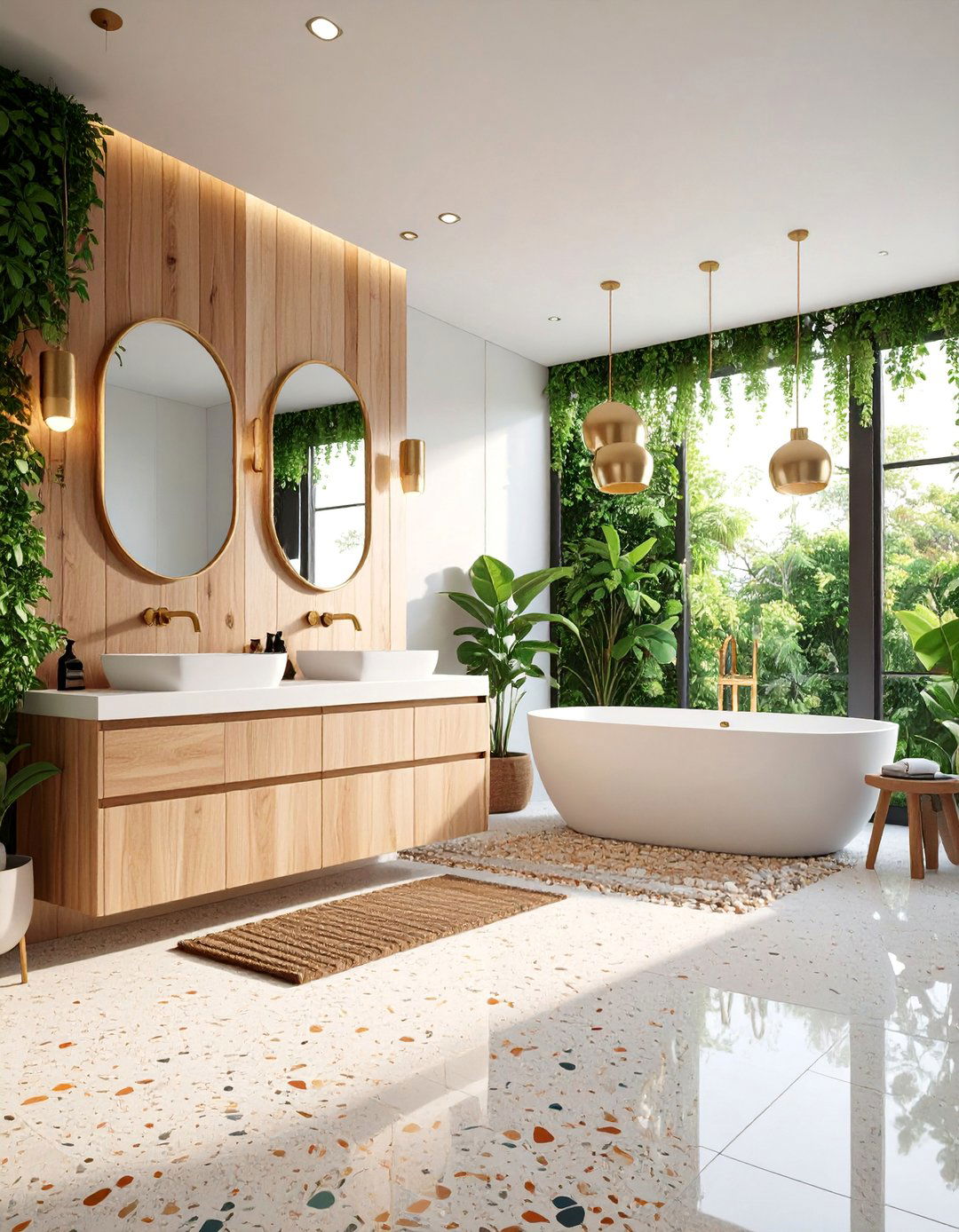
Incorporate terrazzo flooring or wall treatments featuring natural stone chips in neutral colors for subtle texture and visual interest. Choose compositions with white, gray, and beige stone fragments that create organic patterns while maintaining minimalist appeal. Combine terrazzo surfaces with warm wooden vanity elements and natural fiber textiles for material balance. Install simple white fixtures that allow the terrazzo patterns to serve as decorative elements without overwhelming the space. Add brass or copper accents through lighting fixtures and hardware for warmth and sophistication. Include large format mirrors that reflect natural light and visually expand the space. Complete with carefully chosen plants in ceramic planters that complement the stone composition while adding life and natural color to the neutral palette essential for creating serene Japandi environments.
9. Glass and Natural Light Maximization

Design a bathroom that prioritizes natural illumination through strategic placement of windows, skylights, and glass partitions. Install large windows with frosted or textured glass that maintains privacy while allowing maximum daylight penetration. Use glass shower enclosures with minimal framing to maintain visual openness and light flow throughout the space. Choose light-colored natural materials like pale stone and bleached wood that reflect and amplify available light. Add skylights above the bathtub or vanity areas for dramatic natural lighting effects. Include minimal window treatments in natural linen or bamboo that can filter light when needed. Position mirrors strategically to bounce light into darker corners. Complete with light-colored ceramic or stone tiles that enhance brightness while maintaining the clean, airy atmosphere that characterizes successful Japandi bathroom design.
10. Organic Curved Vanity Design
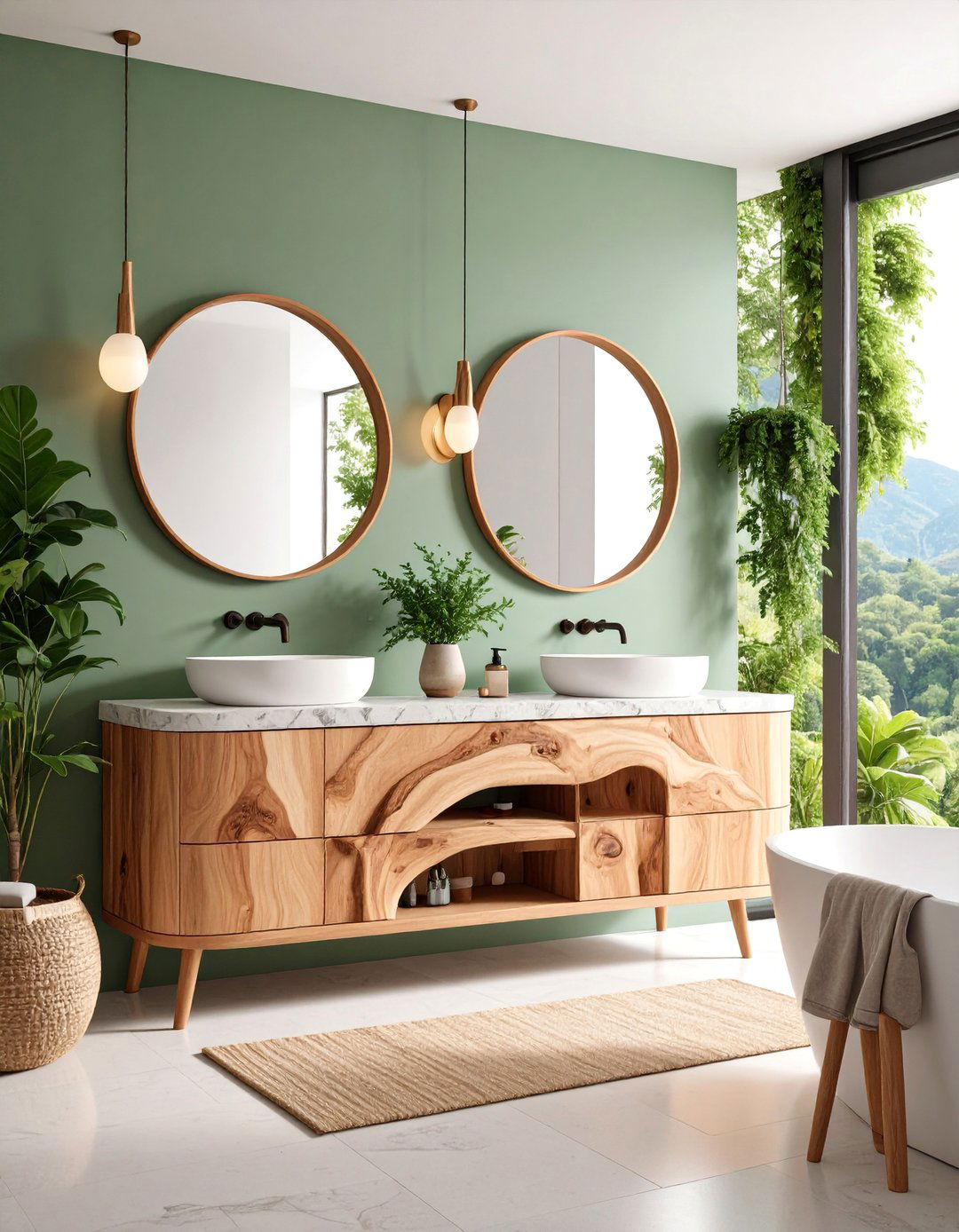
Create visual softness with a custom vanity featuring gentle curved edges and organic flowing lines. Choose warm wood construction in oak or walnut with natural live-edge details that celebrate imperfection. Design integrated storage with hidden compartments that maintain clean surfaces while providing practical organization. Top the curved vanity with natural stone that follows the flowing lines of the wood base. Install round or oval mirrors that echo the organic shapes throughout the design. Add pendant lighting with curved glass or natural material shades that complement the vanity's flowing form. Include brass or wooden hardware with organic shapes that reinforce the natural theme. Complete with plants in ceramic vessels that enhance the organic aesthetic while providing natural air purification and connection to nature essential in Japandi design philosophy.
11. Matte Black Accent Modern Japandi
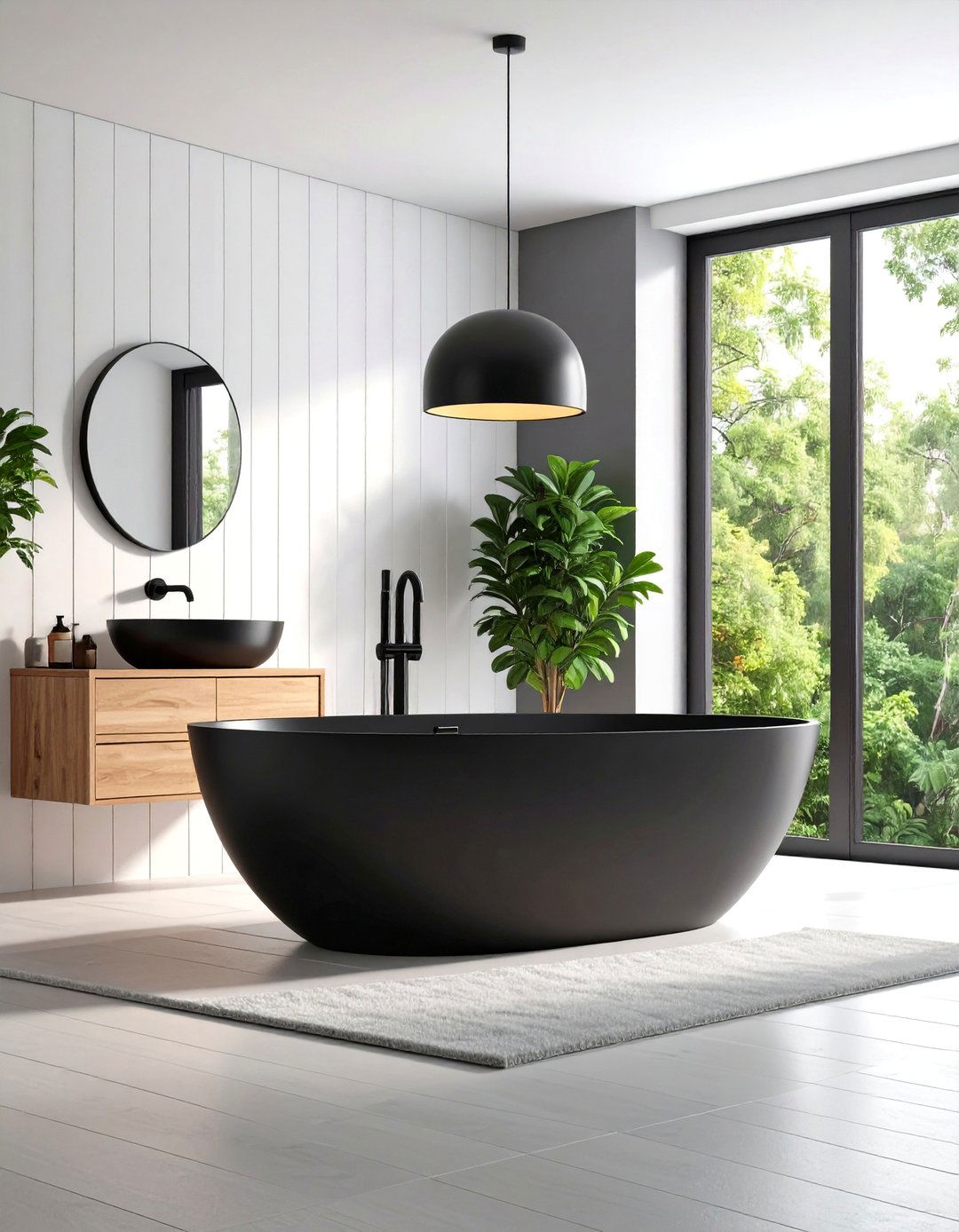
Introduce sophisticated contrast using matte black fixtures and accents against neutral backgrounds of white, beige, and natural wood. Install black freestanding bathtub with simple geometric form as a dramatic focal point. Choose matte black faucets, shower fixtures, and hardware that provide sleek modern contrast. Add black-framed mirrors and lighting fixtures that create visual anchors throughout the space. Balance dark accents with light wood vanity cabinetry and natural stone surfaces. Include black ceramic accessories and planters that maintain color consistency while adding functional elements. Choose white or light gray tiles for walls and floors that allow black accents to create striking visual impact. Complete with natural textiles in white and beige that soften the contrast while maintaining the sophisticated, contemporary interpretation of traditional Japandi design principles.
12. Living Plant Wall Feature
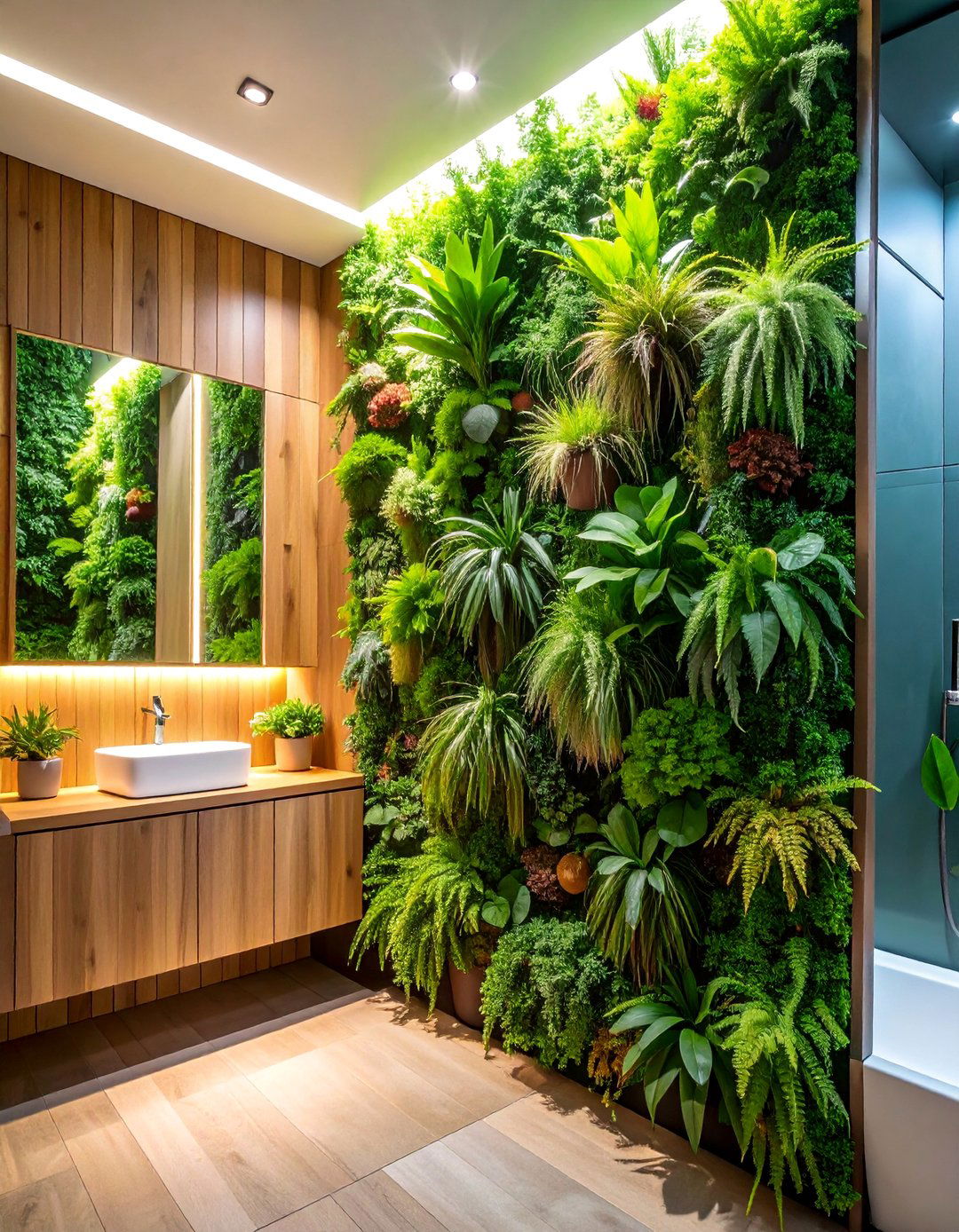
Transform one bathroom wall into a living vertical garden using humidity-loving plants that thrive in bathroom conditions. Install a vertical planting system with proper drainage and irrigation for ferns, pothos, and air plants. Choose plants with varying shades of green and different leaf textures to create natural visual interest. Combine the plant wall with natural wood or stone surfaces that complement the organic elements. Add grow lights with warm color temperature that support plant health while providing ambient illumination. Include a simple irrigation system that maintains proper moisture levels without creating maintenance challenges. Position the plant wall near the bathtub or shower where humidity levels support healthy growth. Complete with natural materials throughout the rest of the space that allow the living wall to serve as the primary organic focal point.
13. Heated Stone Floor Luxury
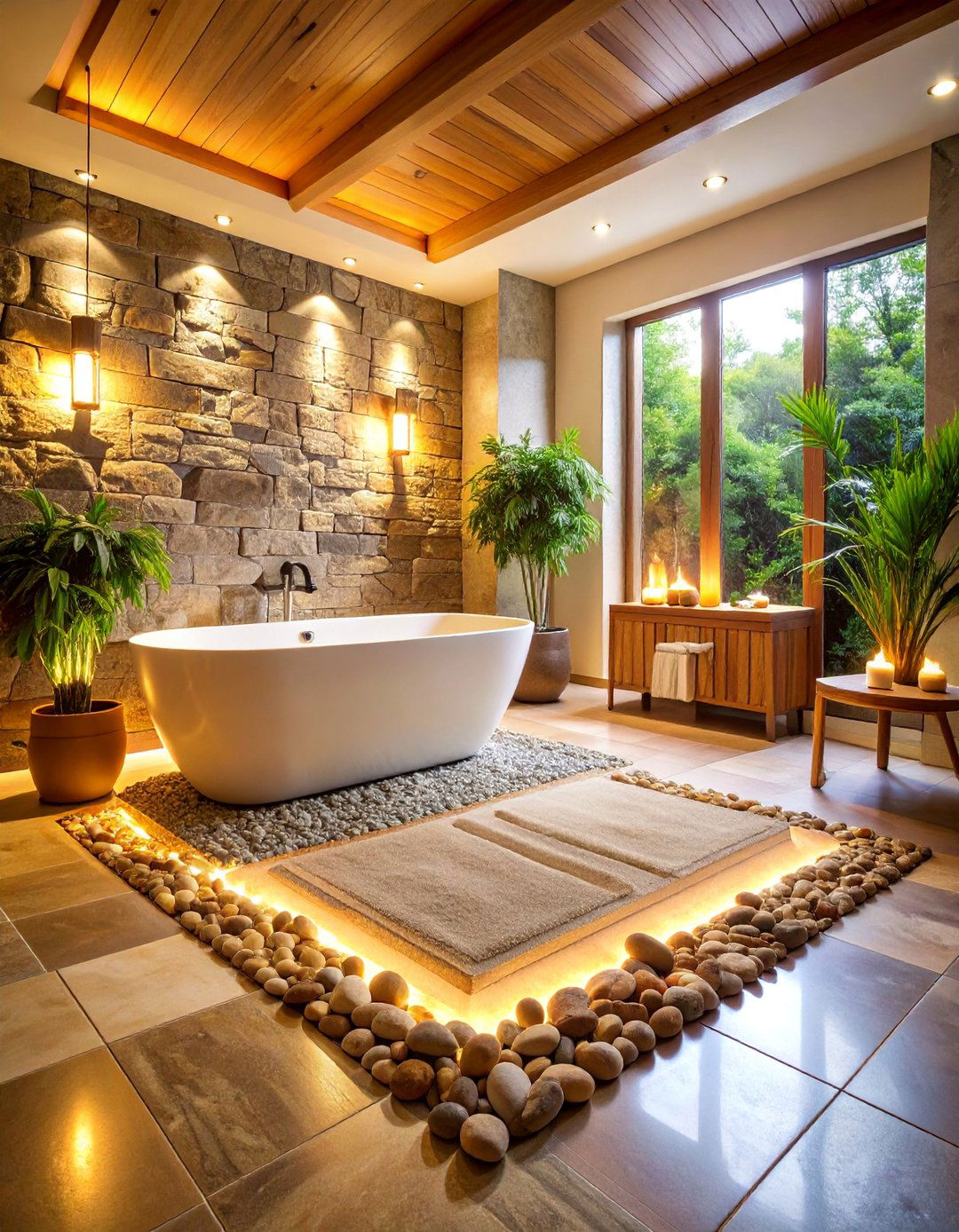
Install radiant heated stone flooring using natural materials like travertine, slate, or limestone for ultimate comfort and luxury. Choose large format tiles with minimal grout lines to create seamless, clean surfaces. Add programmable temperature controls that maintain optimal warmth during morning and evening routines. Combine heated floors with underfloor lighting that creates subtle ambient illumination. Include natural stone or wooden bath mats that provide texture while allowing the heated floor benefits. Choose stone varieties with natural variation and subtle patterns that add interest without disrupting minimalist aesthetics. Add matching stone elements throughout the space including shower surrounds and vanity tops for cohesive material flow. Complete with natural textiles and wooden accents that balance the stone's coolness with warmth, creating the comfortable, luxurious atmosphere central to Japandi design philosophy.
14. Sliding Shoji Screen Privacy
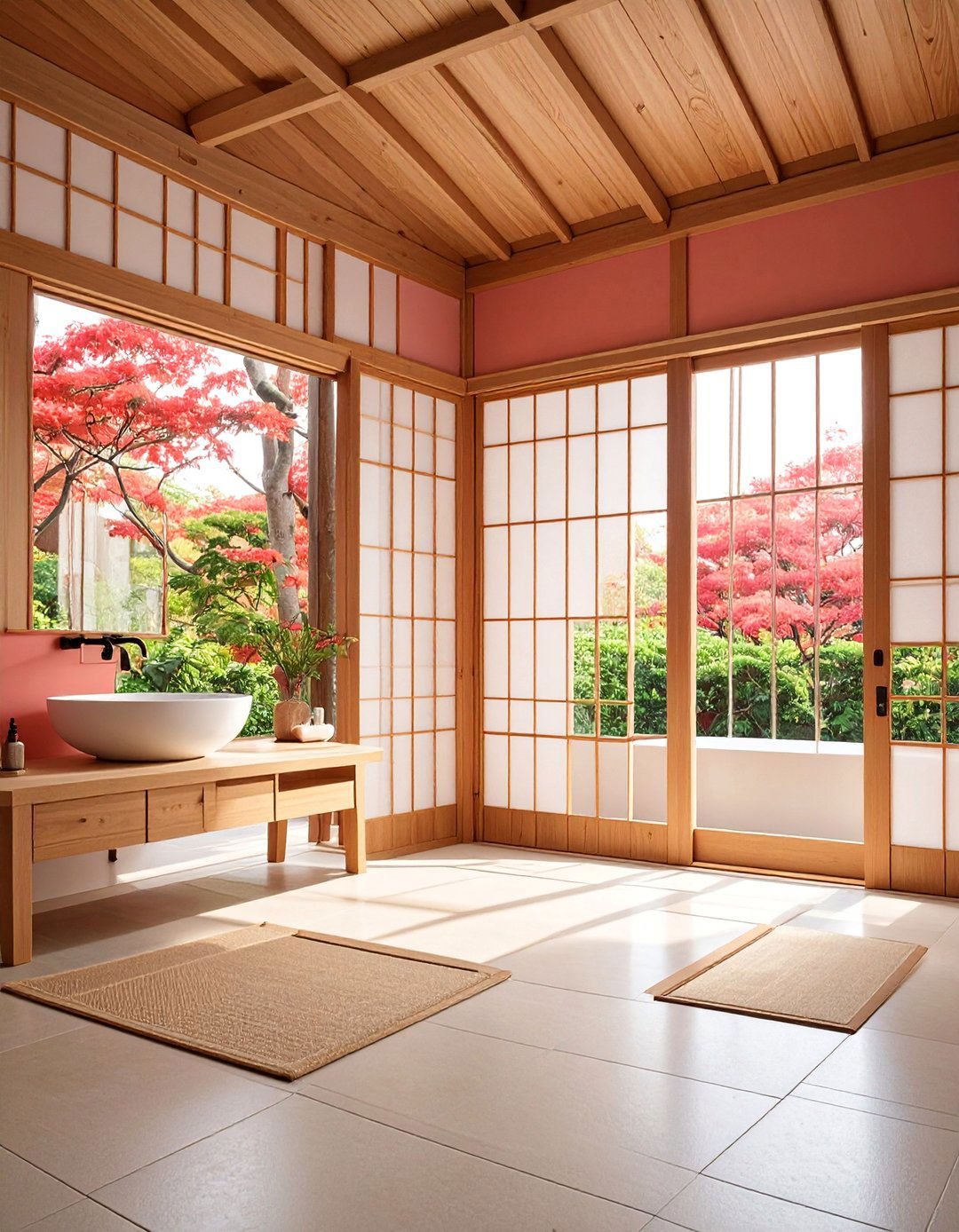
Incorporate traditional Japanese sliding screens made from natural wood frames and translucent materials for flexible privacy and light control. Position screens to separate toilet areas, create shower enclosures, or divide larger bathroom spaces into functional zones. Choose sustainable wood construction with traditional joinery techniques that showcase craftsmanship and attention to detail. Use natural fiber or frosted glass panels that filter light while maintaining visual connection between spaces. Install tracks and hardware in coordinating wood or metal finishes that support smooth operation. Add integrated storage within screen frames for towels and bathroom essentials. Include soft lighting behind screens that creates gentle illumination and highlights the natural materials. Complete with minimal furnishings and natural accessories that allow the screens to serve as both functional and decorative elements while honoring traditional Japanese design principles.
15. Textured Lime Wash Wall Treatment
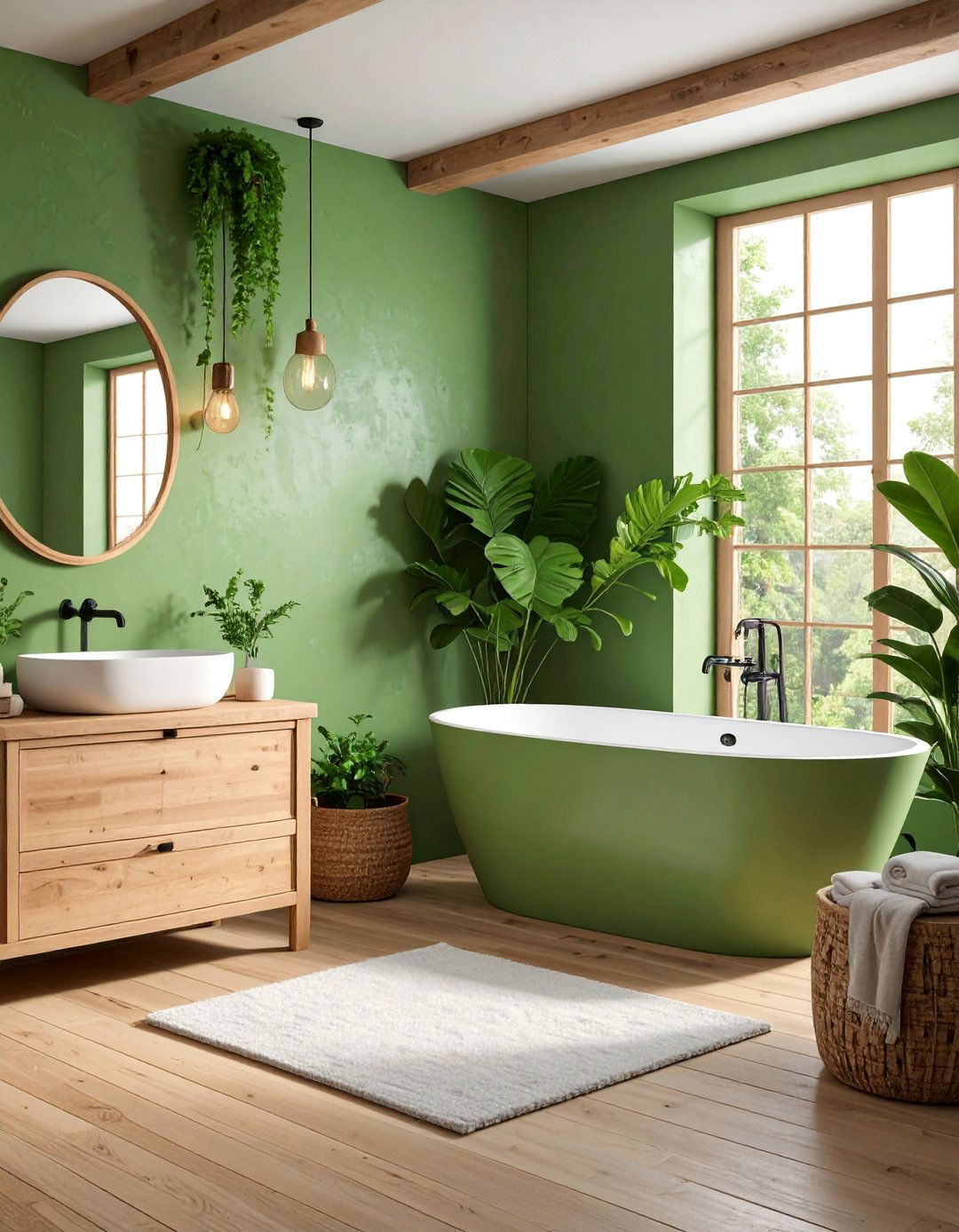
Apply natural lime wash finishes to bathroom walls for organic texture and subtle color variation that embodies wabi-sabi philosophy. Choose neutral colors like warm white, soft beige, or pale gray that create calming backgrounds. Layer different application techniques to achieve varying texture levels and natural imperfections that celebrate handcrafted beauty. Combine lime wash walls with natural wood and stone elements for material harmony. Add waterproof sealers in wet areas while maintaining the natural breathable properties of lime. Include lighting that highlights the textural qualities and creates interesting shadow patterns throughout the day. Choose fixtures and accessories in natural materials that complement the organic wall treatment. Complete with plants and natural textiles that enhance the earthy, natural atmosphere while maintaining the sophisticated simplicity that defines successful Japandi bathroom design.
16. Copper and Brass Warm Accents
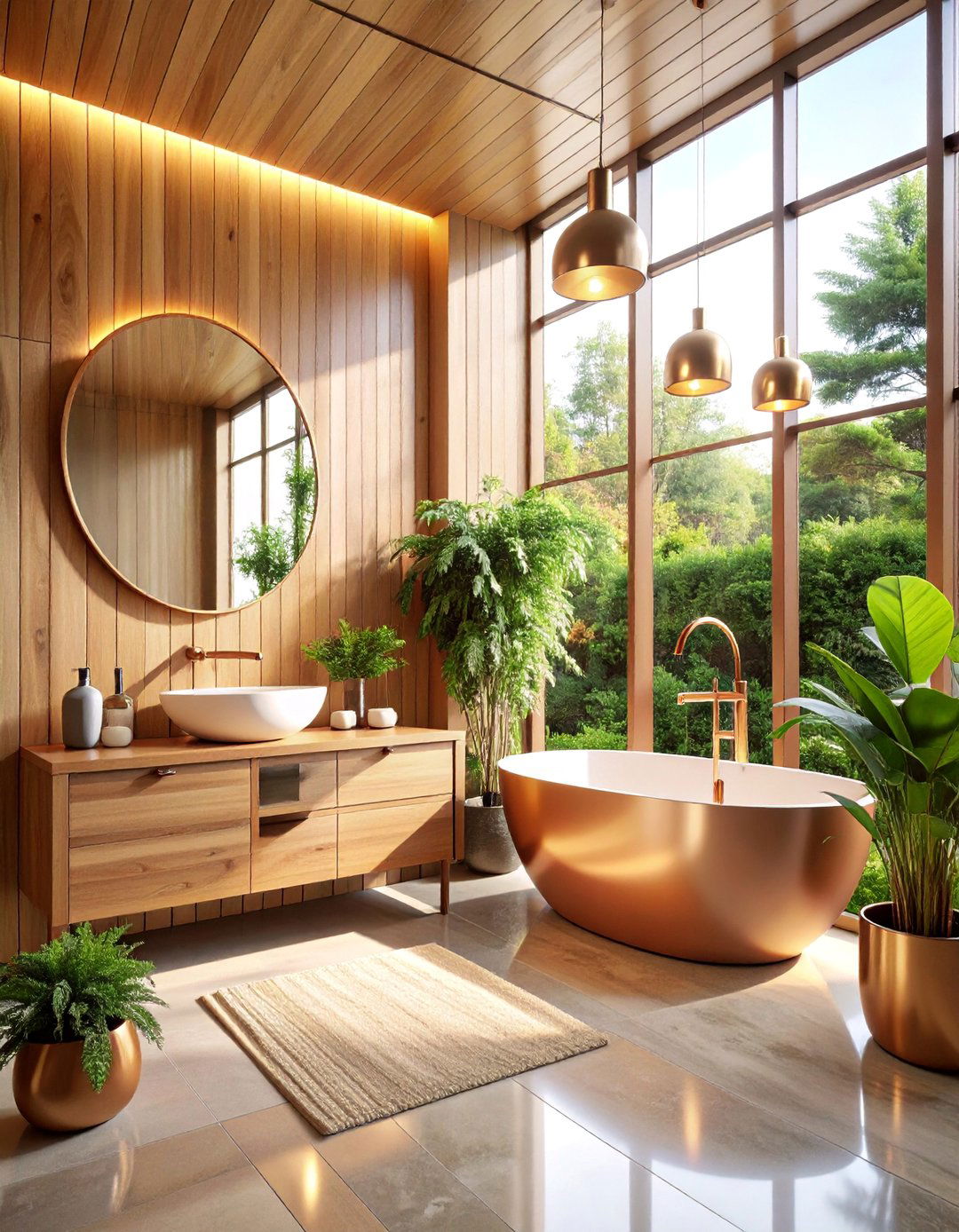
Introduce warm metallic elements through copper or brass fixtures, lighting, and accessories that add richness to neutral color palettes. Choose brushed or aged finishes that develop natural patina over time, celebrating the beauty of change and imperfection. Install copper or brass faucets, shower fixtures, and cabinet hardware for consistent metallic warmth. Add pendant lights or sconces with warm metal finishes that create ambient illumination. Include copper planters or brass mirrors that serve as decorative focal points while maintaining functionality. Balance warm metals with cool stone and natural wood surfaces for material harmony. Choose accessories like soap dispensers and towel bars in coordinating metallic finishes. Complete with natural textiles in warm neutral colors that complement the metallic accents while maintaining the calm, sophisticated atmosphere essential to Japandi aesthetic principles.
17. Built-In Storage Zen Organization
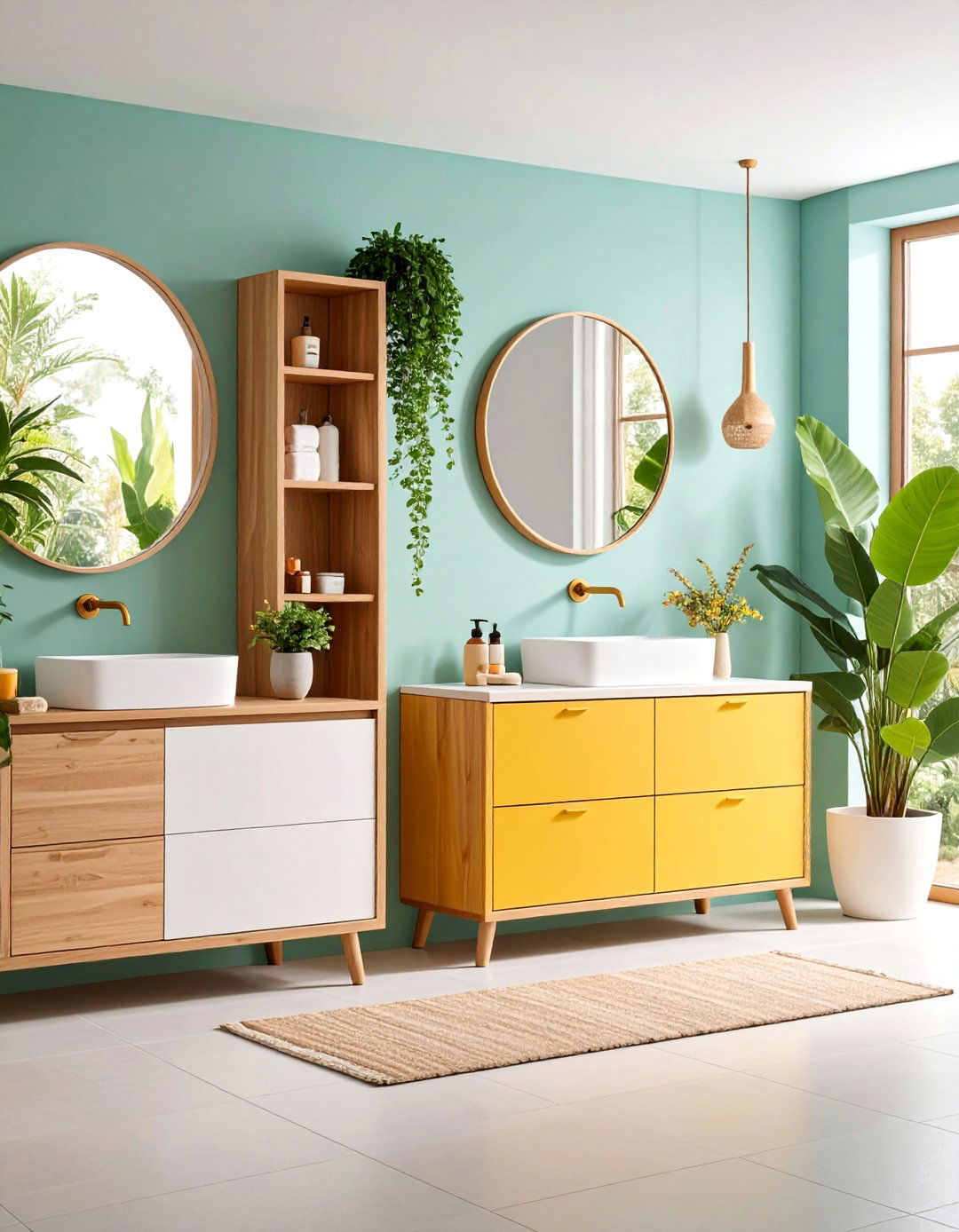
Design comprehensive built-in storage solutions that maintain clutter-free surfaces while providing ample organization for bathroom essentials. Create recessed wall niches with natural stone or wood trim for storing toiletries and decorative objects. Install vanity cabinetry with hidden compartments, soft-close drawers, and interior organizers that maximize efficiency. Add medicine cabinets with mirrored fronts that provide storage without visual disruption. Include built-in hampers and towel storage that maintain clean lines throughout the space. Choose hardware in natural materials or coordinating metal finishes that support the overall design aesthetic. Incorporate lighting within storage areas for practical illumination and visual interest. Complete with minimal visible accessories and natural materials that allow the clean, organized environment to promote tranquility and mindfulness central to Japandi philosophy.
18. Natural Fiber Textile Layering
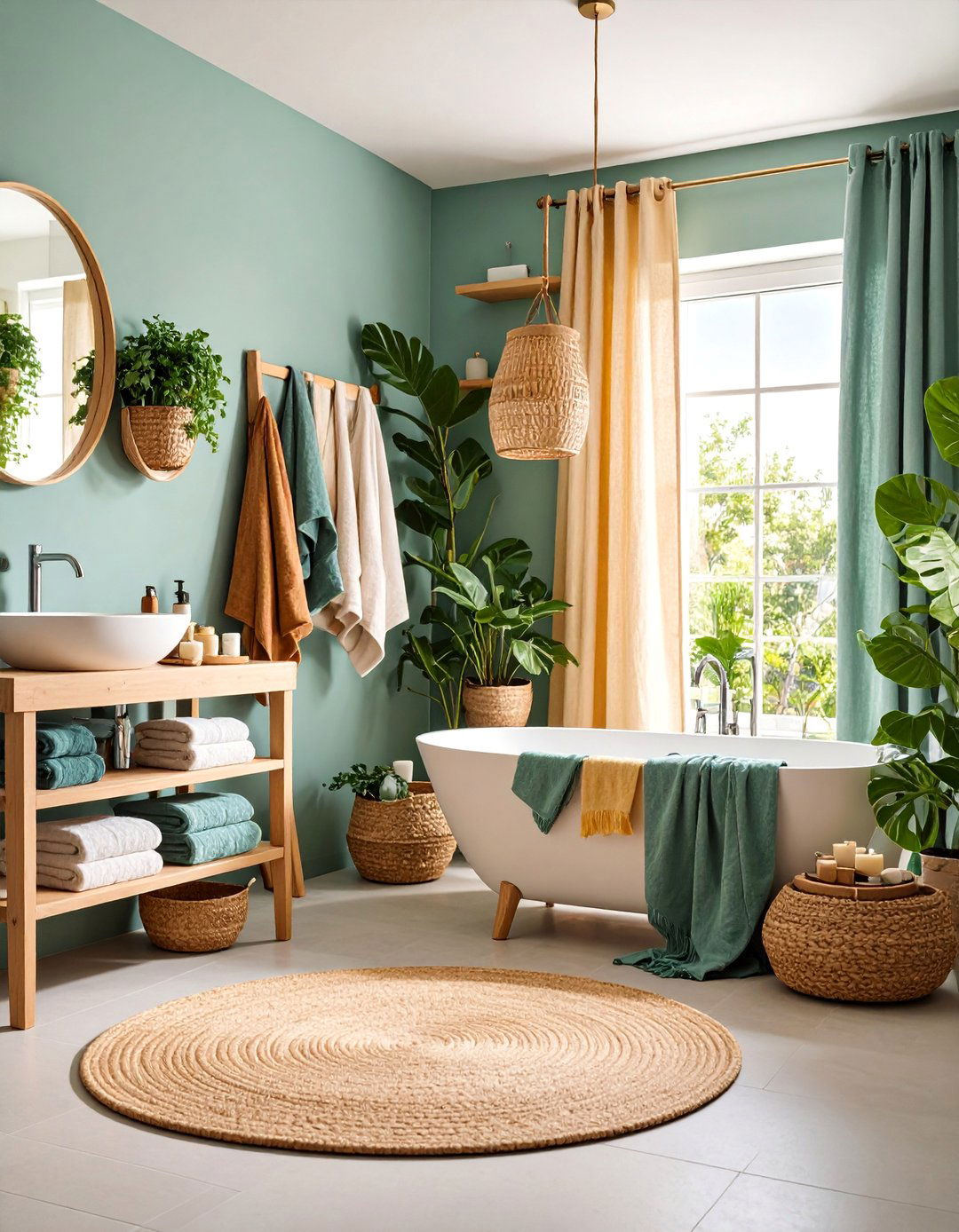
Create warmth and comfort through carefully layered natural textiles including organic cotton towels, linen shower curtains, and bamboo bath mats. Choose neutral colors in various textures that add visual and tactile interest while maintaining color harmony. Include wooden towel bars and hooks that complement textile choices while providing functional storage. Add bath robes and slippers in natural fibers that enhance the spa-like experience. Choose window treatments in linen or bamboo that filter light while maintaining privacy. Include baskets woven from natural materials for storing extra towels and bathroom supplies. Layer different textile weights and weaves to create depth without visual clutter. Complete with plants and natural accessories that enhance the organic, comfortable atmosphere while supporting the emphasis on natural materials fundamental to Japandi design principles.
19. Skylighted Bathing Sanctuary
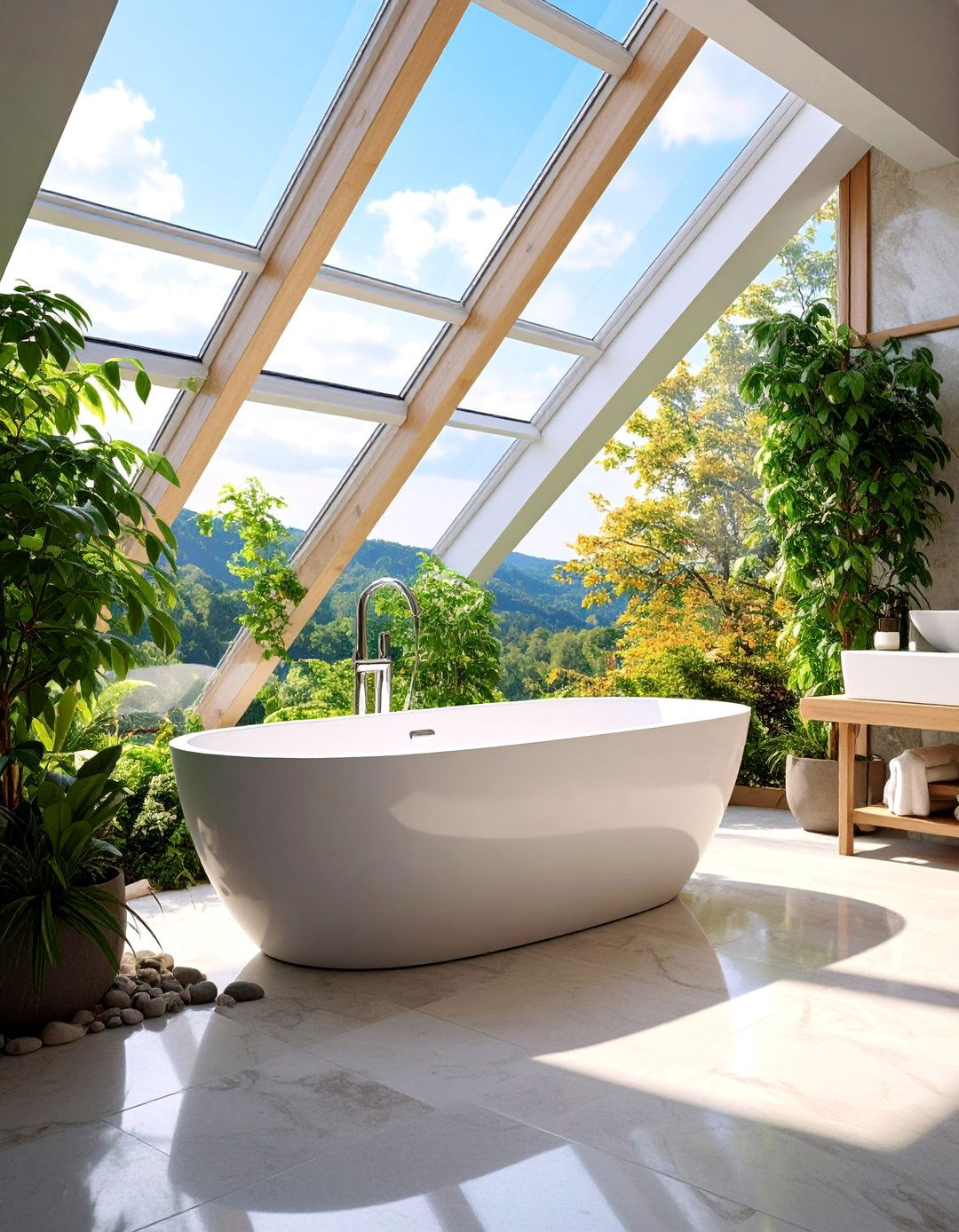
Position a freestanding bathtub directly beneath a large skylight for dramatic natural illumination and connection to outdoor elements. Choose a simple white or natural stone tub with clean geometric lines that serve as the room's focal point. Install operable skylights that can provide ventilation and temperature control during bathing rituals. Add light-filtering shades that can control illumination levels while maintaining privacy when needed. Include plants around the tub area that benefit from natural overhead light. Choose natural stone or wooden flooring that creates transition zones around the bathing area. Add minimal seating and storage that don't interfere with the dramatic overhead lighting effects. Complete with simple fixtures and neutral colors that allow the natural light to create changing moods throughout the day while supporting the meditative, nature-connected experience central to Japandi bathroom design.
20. Dual Vessel Sink Vanity
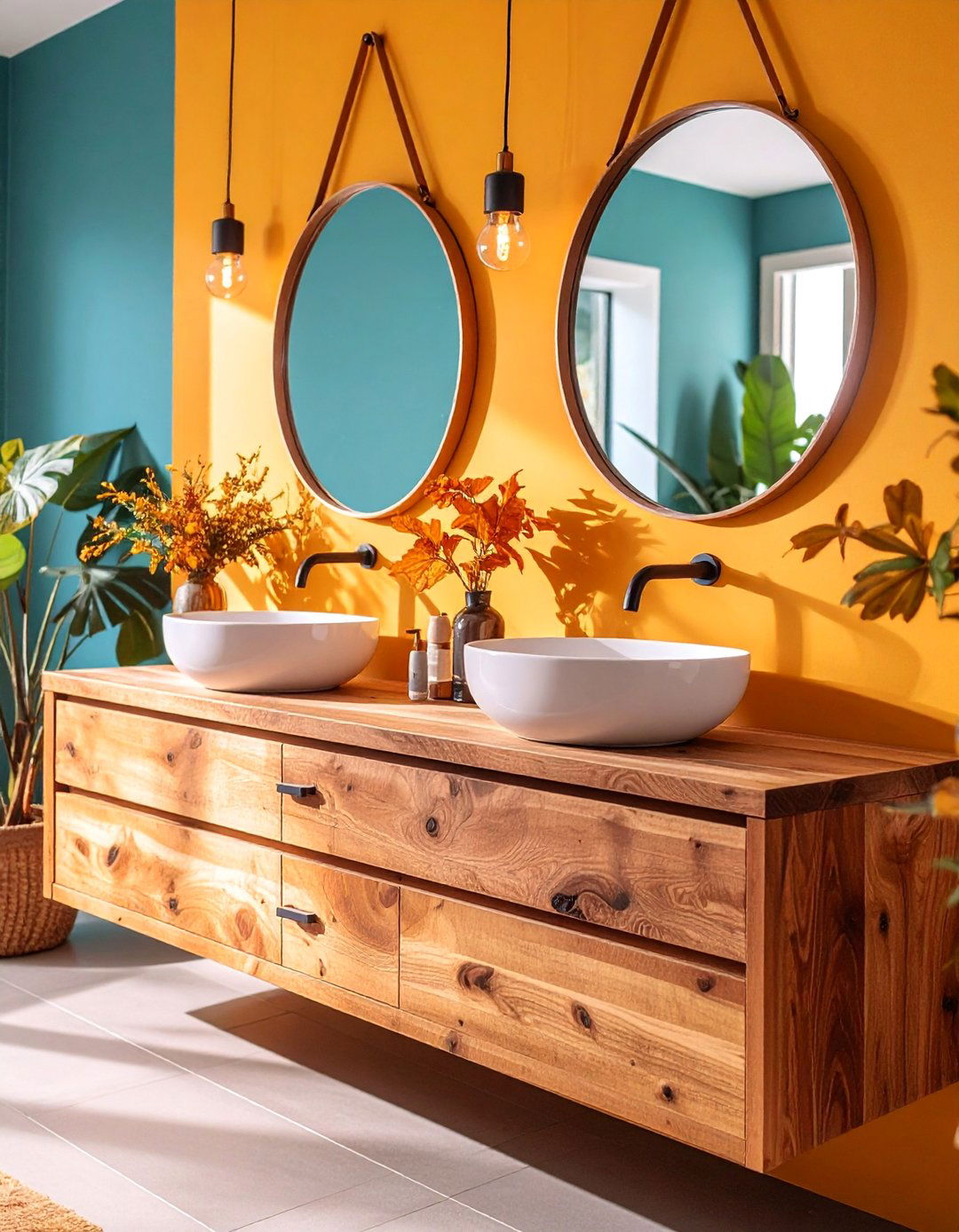
Install two matching vessel sinks on a floating wooden vanity to create symmetrical balance and practical functionality for shared bathrooms. Choose ceramic or natural stone vessels with organic curved shapes that contrast beautifully with geometric vanity lines. Position sinks with adequate spacing and individual storage areas for personal items. Add matching faucets in brushed metal or matte black finishes that provide consistent visual flow. Include individual mirrors or one large mirror that serves both sink areas while maximizing light reflection. Install task lighting above each sink for practical illumination during grooming activities. Choose vanity wood in light oak or bamboo that adds warmth to neutral color schemes. Complete with coordinated accessories and natural textiles that maintain the clean, organized appearance while providing comfortable functionality essential to successful Japandi bathroom design.
21. River Rock Shower Floor

Create a natural spa experience with smooth river rock flooring in the shower area that provides massage-like texture underfoot. Choose uniformly sized stones in neutral gray and beige colors that create flowing patterns and excellent drainage. Install proper waterproofing and drainage systems that support the natural stone installation. Add handheld shower fixtures that allow for easy cleaning and maintenance of the rock surface. Include built-in seating made from matching stone or natural wood for comfort and relaxation. Choose shower walls in complementary natural materials like stone tiles or wooden planks. Add plants that thrive in humid conditions near the shower area for natural air purification. Complete with minimal fixtures and natural lighting that enhance the organic textures while creating the peaceful, nature-connected atmosphere fundamental to Japandi design philosophy.
22. Minimalist Pendant Lighting Design

Install sculptural pendant lights with clean geometric forms or natural material construction that provide both task and ambient illumination. Choose fixtures made from wood, bamboo, or natural fiber that complement the organic material palette. Position pendants at varying heights to create visual interest while maintaining functional lighting distribution. Add dimmable controls that allow adjustment for different activities and moods throughout the day. Include LED bulbs with warm color temperature that create comfortable, inviting illumination. Choose cord and hardware finishes that coordinate with other bathroom fixtures and accessories. Balance pendant lighting with natural light sources and recessed fixtures for comprehensive illumination. Complete with natural materials and neutral colors that allow the pendant lights to serve as sculptural focal points while supporting the clean, sophisticated aesthetic central to Japandi interior design principles.
23. Wooden Bench Seating Element
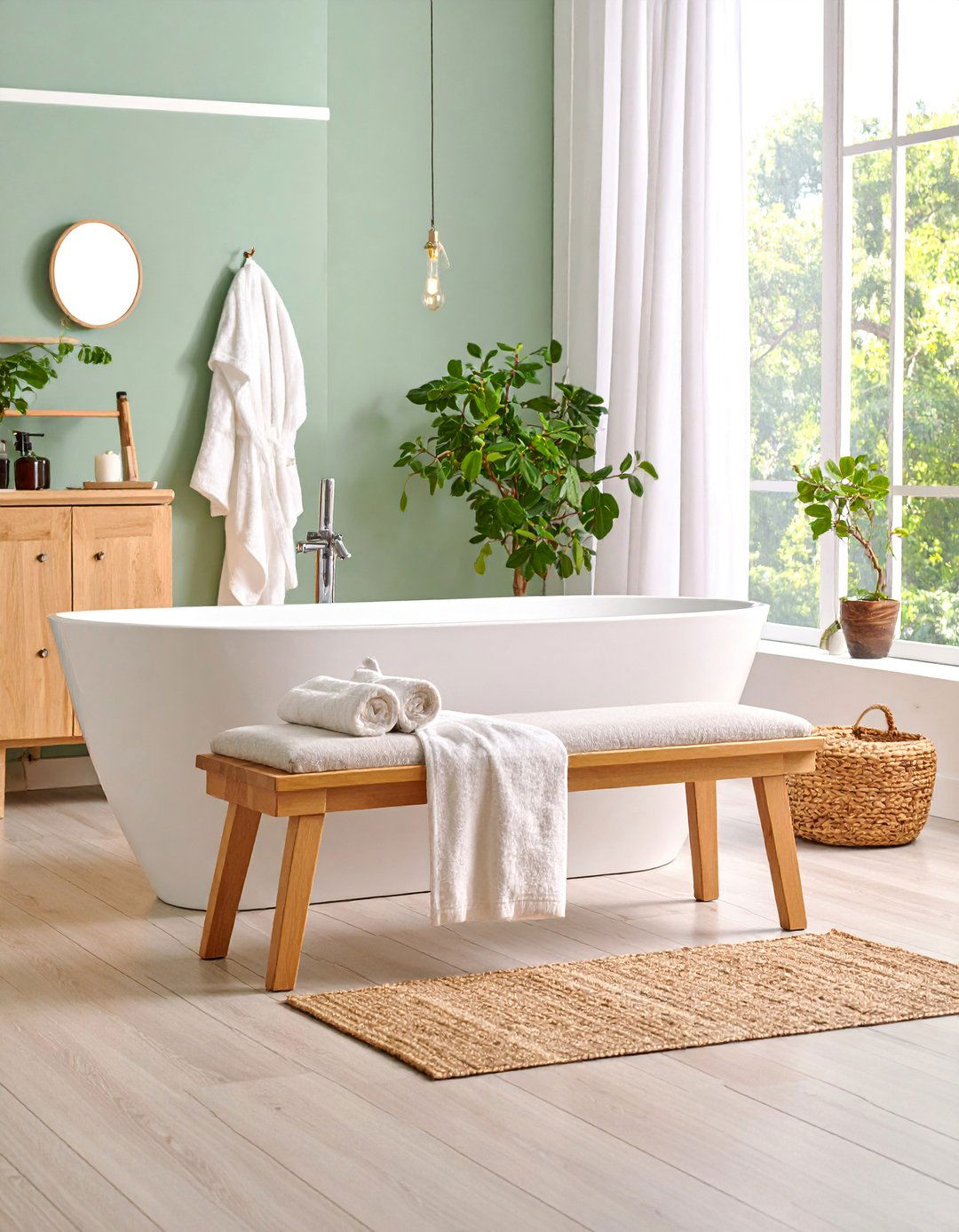
Incorporate a simple wooden bench with clean lines and natural finish that provides seating, storage, and display space for bathroom essentials. Choose sustainable wood construction in oak, teak, or bamboo that resists moisture while aging beautifully over time. Position the bench near the bathtub, vanity, or shower area for maximum functionality and convenience. Add cushions in natural linen or cotton that provide comfort while maintaining washable practicality. Include lower storage areas or open shelving for towels, plants, and decorative objects. Choose wood stains or finishes that complement other wooden elements throughout the bathroom space. Add hardware and details that showcase quality craftsmanship and attention to construction details. Complete with natural accessories and plants that enhance the bench's role as both functional furniture and decorative element supporting Japandi emphasis on beautiful, purposeful design.
24. Neutral Ceramic Tile Patterns

Create visual interest using large format ceramic tiles in subtle geometric or organic patterns that add texture without overwhelming minimalist aesthetics. Choose neutral colors including white, beige, cream, and soft gray that maintain calming atmosphere while providing practical water resistance. Install tiles with minimal grout lines and matching grout colors that create seamless, continuous surfaces. Add accent areas using different tile sizes or subtle pattern variations that create focal points within the neutral palette. Include matte finishes that reduce glare while providing sophisticated texture. Choose tiles with slight variation in tone and pattern that celebrate natural imperfection and handcrafted quality. Balance patterned areas with smooth surfaces and natural materials for visual harmony. Complete with fixtures and accessories in coordinating neutral tones that allow the tile patterns to create subtle visual interest while maintaining the serene, uncluttered environment essential to Japandi design success.
25. Integrated Smart Storage Solutions
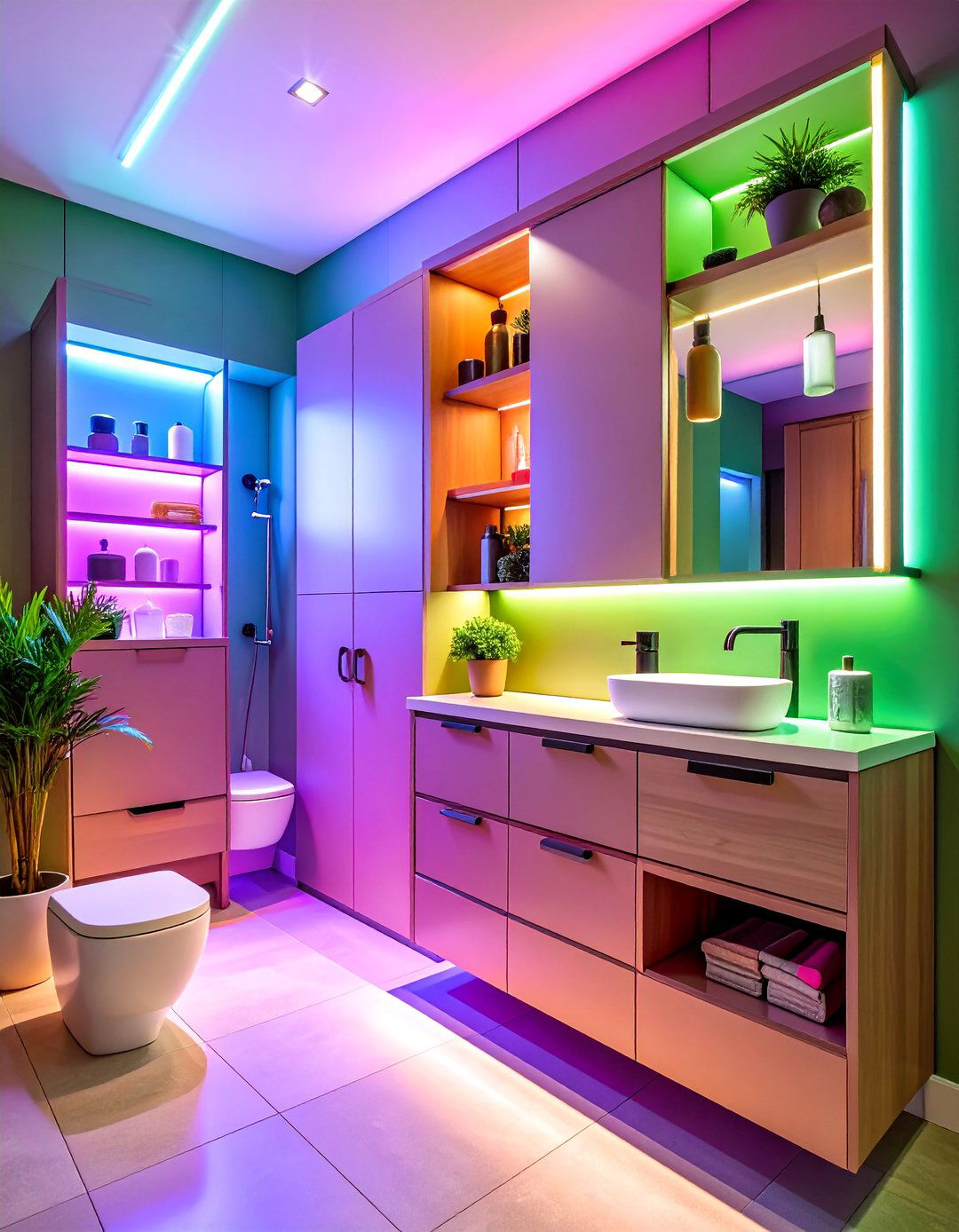
Design intelligent storage systems that blend seamlessly into bathroom architecture while providing comprehensive organization for modern lifestyle needs. Create hidden compartments within vanity cabinetry, wall systems, and even flooring that maintain clean visual lines. Install pull-out drawers, rotating shelves, and adjustable organizers that maximize space efficiency and accessibility. Add electrical outlets and charging stations within storage areas for modern device management. Include ventilation systems that keep stored items fresh and dry in humid bathroom conditions. Choose hardware and mechanisms that operate quietly and smoothly for peaceful bathroom experiences. Integrate lighting within storage areas that provides practical illumination while creating subtle visual interest. Complete with natural materials and finishes that allow smart storage to disappear into the overall design while supporting the organized, clutter-free environment that promotes tranquility fundamental to Japandi lifestyle and aesthetic principles.
Conclusion:
Japandi bathroom design offers timeless appeal through its masterful balance of Japanese minimalism and Scandinavian functionality. These 25 ideas demonstrate how natural materials, neutral colors, and clean lines create serene spaces that promote relaxation and wellbeing. The key lies in embracing simplicity while maintaining warmth and comfort through thoughtful material choices and functional design. Whether incorporating freestanding soaking tubs, natural textures, or smart storage solutions, successful Japandi bathrooms celebrate both beauty and practicality. By focusing on quality craftsmanship, sustainable materials, and connection to nature, these design concepts transform everyday bathrooms into peaceful retreats that support mindful living and lasting satisfaction.



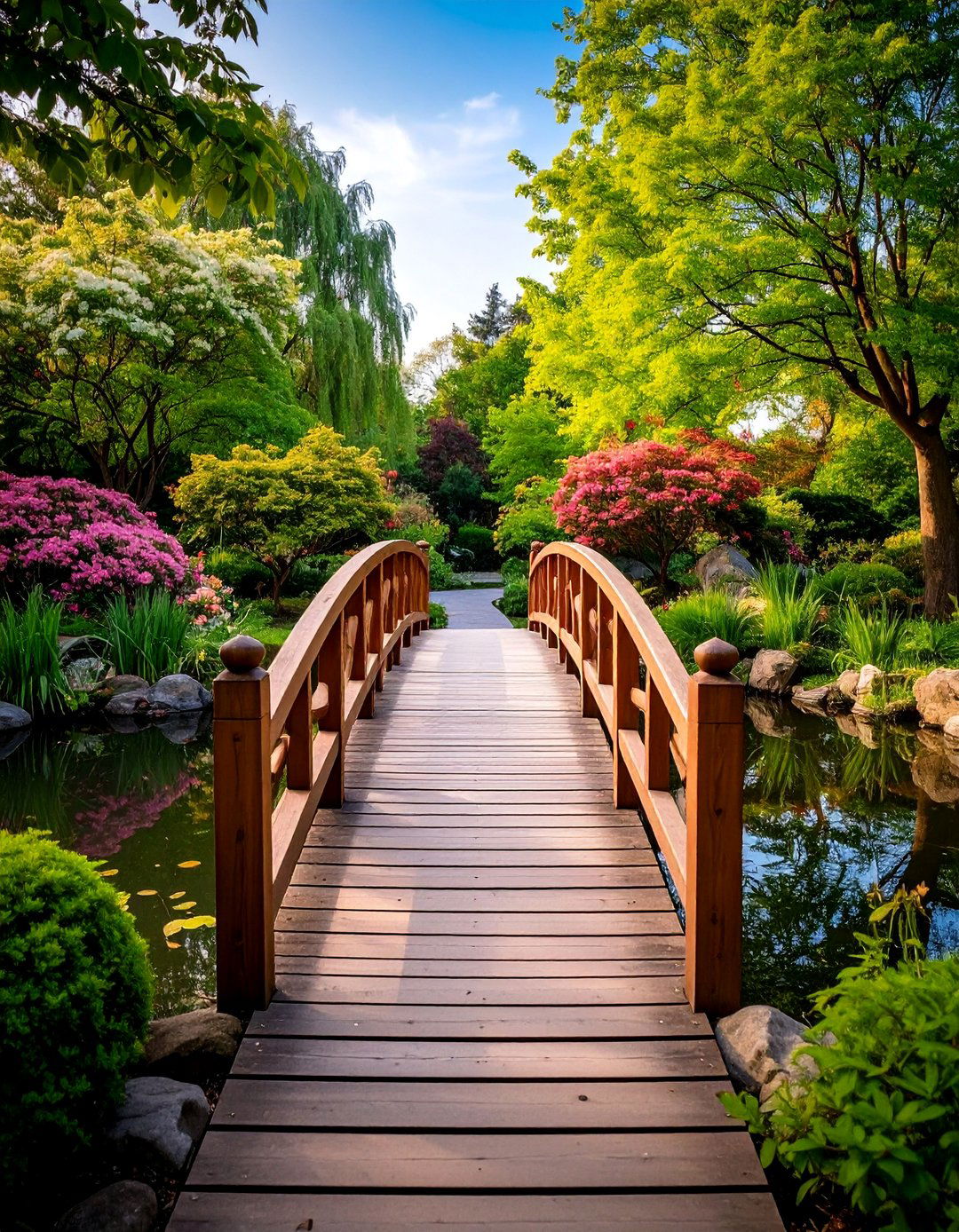

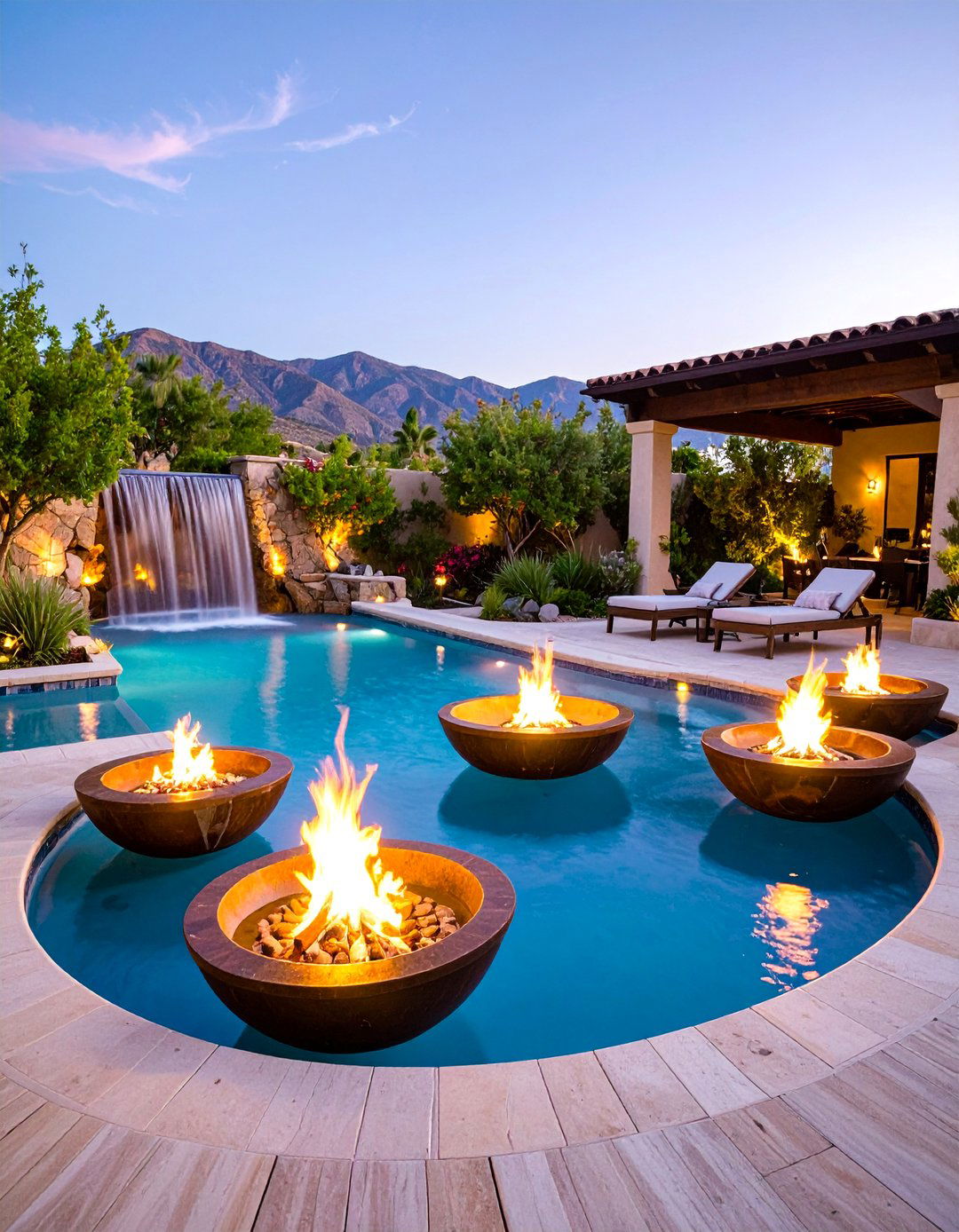


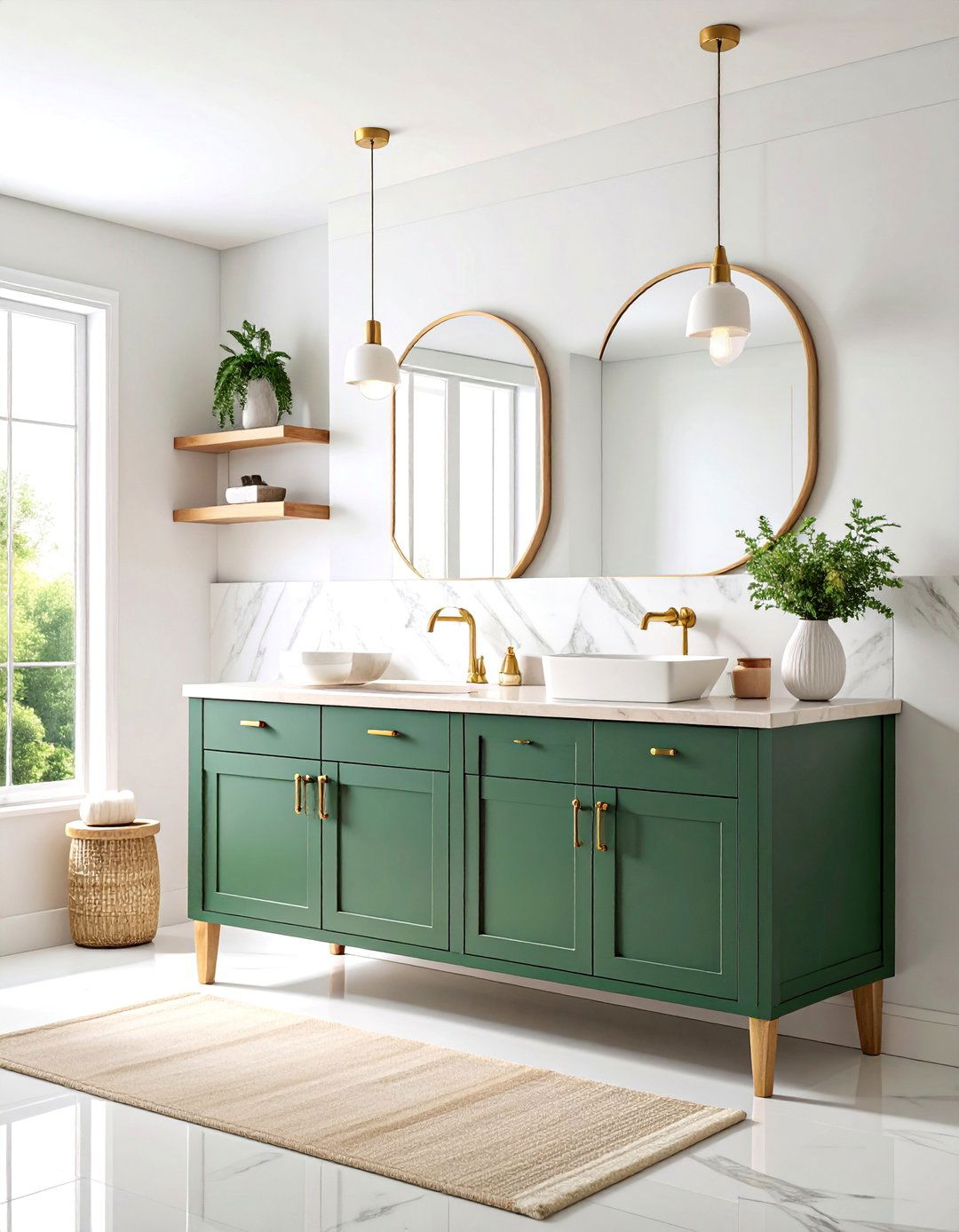
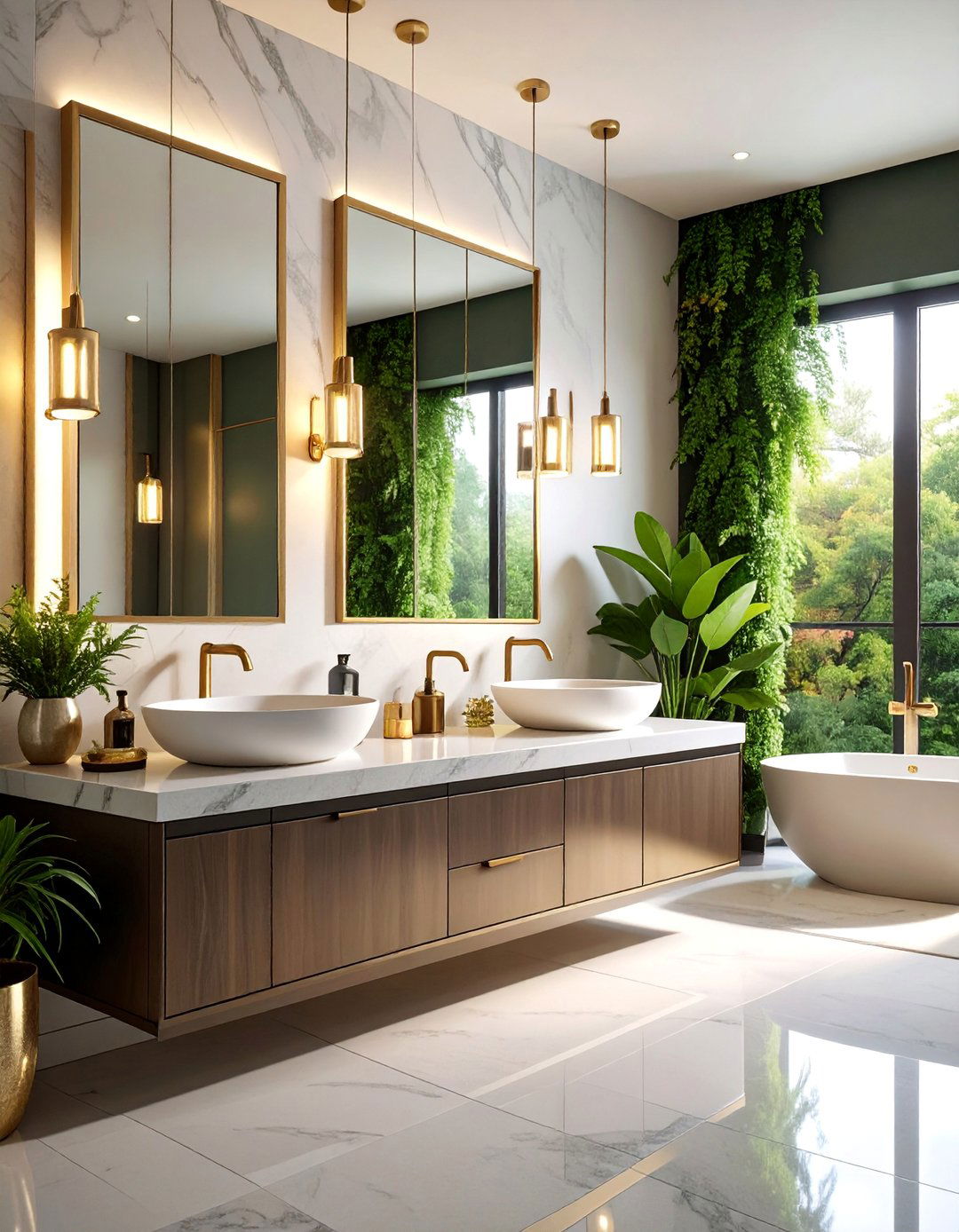

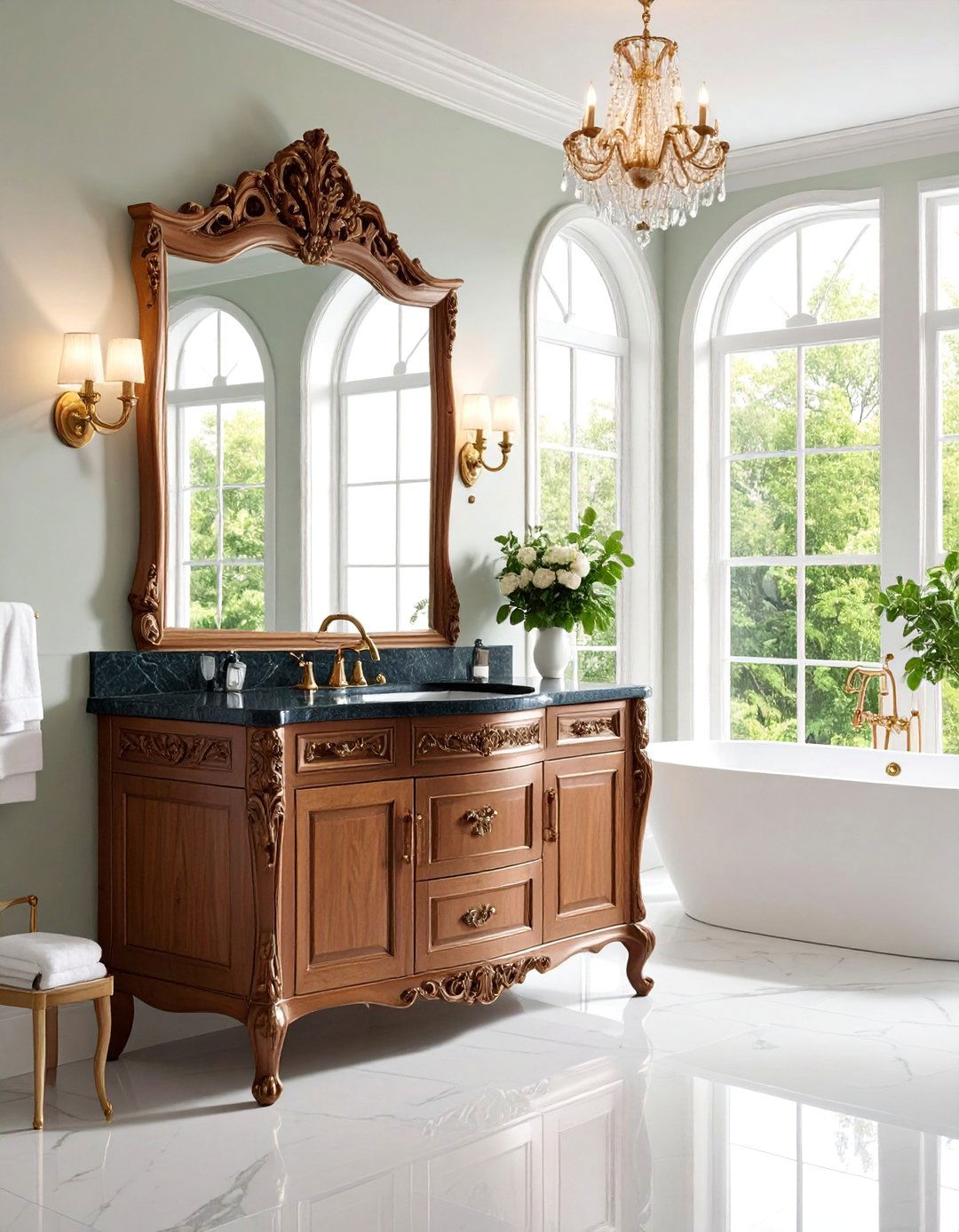
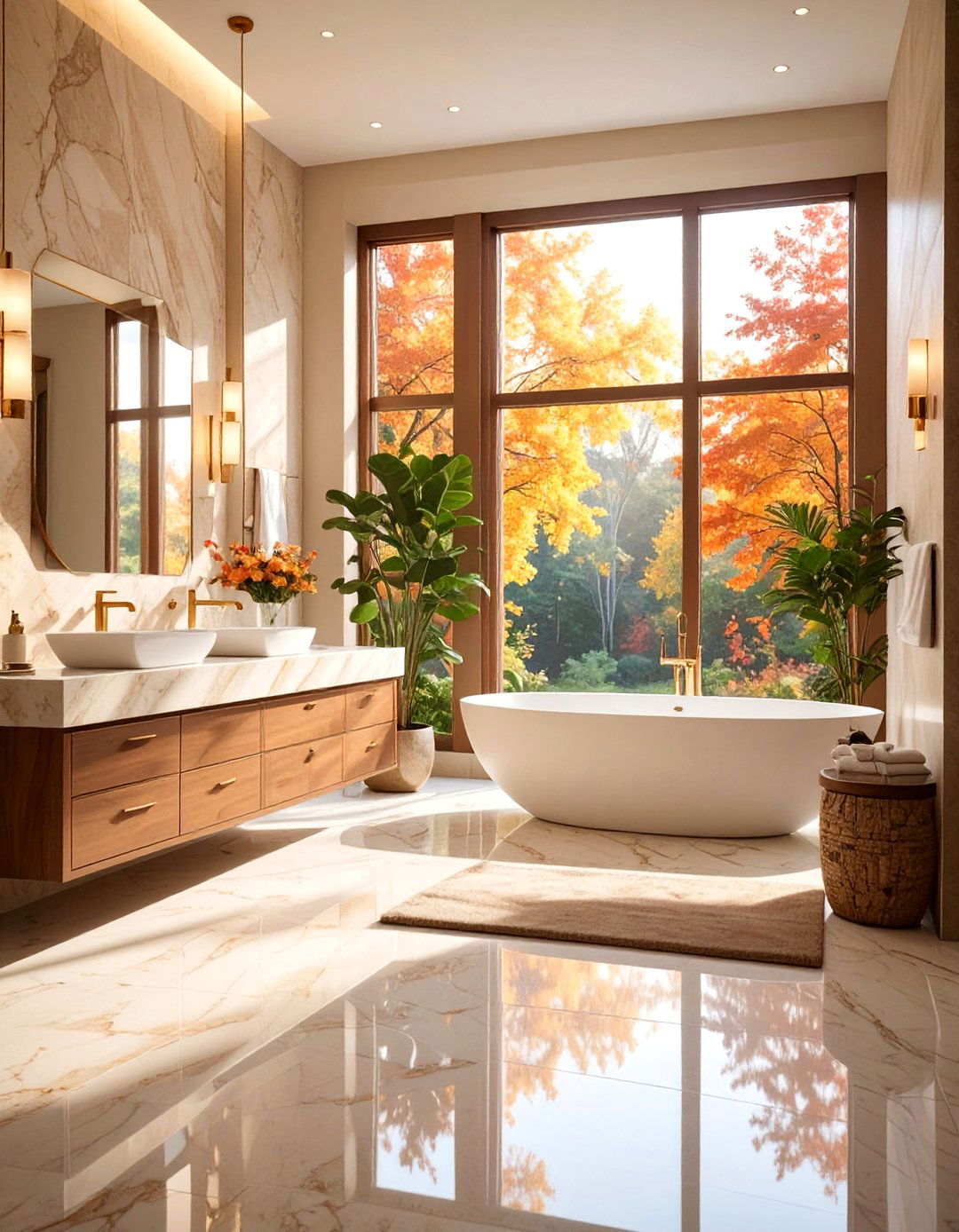
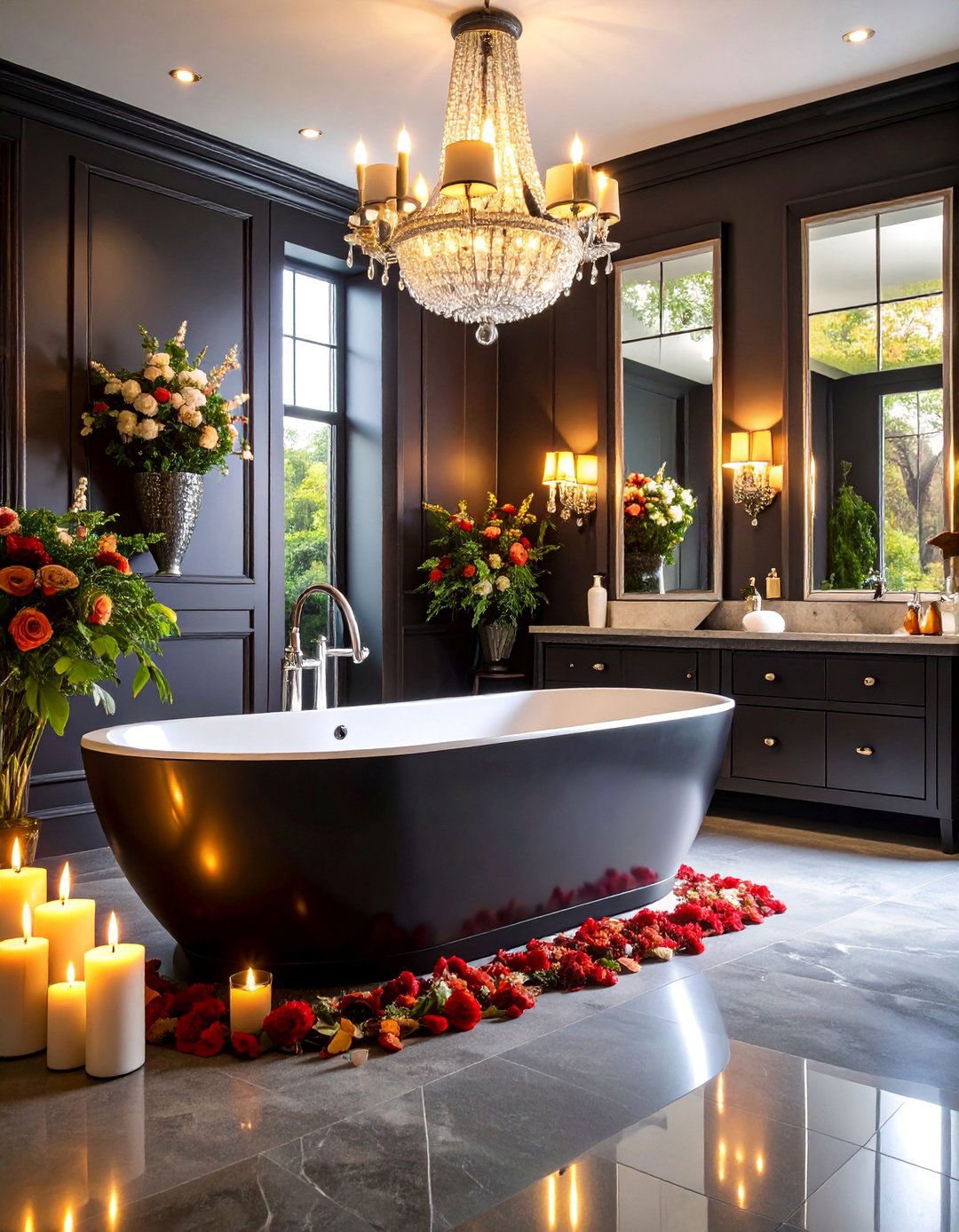


Leave a Reply